Module Slides WHOSteve Ababio Civil society organizations to

Module Slides WHO/Steve Ababio Civil society organizations to promote human rights in mental health and related areas WHO Quality. Rights guidance module Quality. Rights

WHO/MSD/QR/19. 12 © World Health Organization 2019 Some rights reserved. This work is available under the Creative Commons Attribution-Non. Commercial-Share. Alike 3. 0 IGO licence (CC BY-NC-SA 3. 0 IGO; https: //creativecommons. org/licenses/by-nc-sa/3. 0/igo). Under the terms of this licence, you may copy, redistribute and adapt the work for non-commercial purposes, provided the work is appropriately cited, as indicated below. In any use of this work, there should be no suggestion that WHO endorses any specific organization, products or services. The use of the WHO logo is not permitted. If you adapt the work, then you must license your work under the same or equivalent Creative Commons licence. If you create a translation of this work, you should add the following disclaimer along with the suggested citation: “This translation was not created by the World Health Organization (WHO). WHO is not responsible for the content or accuracy of this translation. The original English edition shall be the binding and authentic edition”. Any mediation relating to disputes arising under the licence shall be conducted in accordance with the mediation rules of the World Intellectual Property Organization. Suggested citation. Civil society organizations to promote human rights in mental health and related areas. WHO Quality. Rights Guidance module. Module slides. Geneva: World Health Organization; 2019 (WHO/MSD/QR/19. 12). Licence: CC BY-NC-SA 3. 0 IGO. Sales, rights and licensing. To purchase WHO publications, see http: //apps. who. int/bookorders. To submit requests for commercial use and queries on rights and licensing, see http: //www. who. int/about/licensing. Third-party materials. If you wish to reuse material from this work that is attributed to a third party, such as tables, figures or images, it is your responsibility to determine whether permission is needed for that reuse and to obtain permission from the copyright holder. The risk of claims resulting from infringement of any third-party-owned component in the work rests solely with the user. General disclaimers. The designations employed and the presentation of the material in this publication do not imply the expression of any opinion whatsoever on the part of WHO concerning the legal status of any country, territory, city or area or of its authorities, or concerning the delimitation of its frontiers or boundaries. Dotted and dashed lines on maps represent approximate border lines for which there may not yet be full agreement. The mention of specific companies or of certain manufacturers’ products does not imply that they are endorsed or recommended by WHO in preference to others of a similar nature that are not mentioned. Errors and omissions excepted, the names of proprietary products are distinguished by initial capital letters. All reasonable precautions have been taken by WHO to verify the information contained in this publication. However, the published material is being distributed without warranty of any kind, either expressed or implied. The responsibility for the interpretation and use of the material lies with the reader. In no event shall WHO be liable for damages arising from its use. Cover photo. WHO/Steve Ababio Accompanying course guide is available here https: //www. who. int/publications-detail/who-qualityrights-guidance-and-training-tools

WHO Quality. Rights: Goals and objectives GOAL: Improve access to good quality mental health and social services and to promote the human rights of people with mental health conditions, psychosocial, intellectual or cognitive disabilities • Build capacity to combat stigma and discrimination and promote human rights and recovery • Improve the quality and human rights conditions in mental health and social services • Create community-based services and recovery-oriented services that respect and promote human rights • Support the development of a civil society movement to conduct advocacy and influence policymaking • Reform national policies and legislation in line with the CRPD and other international human rights standards 3

A few words about terminology - 1 • Language and terminology are used differently by different people in different contexts. • “Psychosocial disability” includes people who have received a mental health-related diagnosis or who self-identify with this term. • “Cognitive disability” and “intellectual disability” refer to people who have received a diagnosis related to their cognitive or intellectual function, including dementia and autism. • The term “disability” highlights the barriers that hinder the full participation in society of people with actual or perceived impairments and the fact that they are protected under the CRPD. • The use of “disability” in this context does not imply that people have an impairment or a disorder. 4

A few words about terminology - 2 • “People who are using” or “who have previously used” mental health and social services refer to people who do not necessarily identify as having a disability but who have a variety of experiences applicable to this training. • The term “mental health and social services” refers to a wide range of services provided by countries within the public, private and nongovernmental sectors. • Terminology has been chosen for inclusiveness. • It is a personal choice to self-identify with certain expressions or concepts, but human rights apply to everyone everywhere. • A diagnosis or disability should never define a person. • We are all individuals, with a unique social context, personality, goals, aspirations and relationships with others. 5

Topics covered in this module • What is a civil society organization • Setting up a civil society organization • Day-to-day operation of the organization • Monitoring, evaluation and reporting • Sustainability 6

1. Introduction • This guidance module aims to assist people with psychosocial, intellectual or cognitive disabilities, as well as their supporters, to set up and run a civil society organization. • Civil society organizations may consist solely of persons with disabilities or may also have other members. • The module suggests how to structure the organization, design its focus and operations, monitor and report on progress. 7

2. What is a civil society organization? 8

2. What is a civil society organization? • A civil society organization is a non-state organization that aims to advance a common interest. • It works to bring about important change in an area deemed as important. • Organizations of persons with disabilities (incl psychosocial, intellectual or cognitive disabilities) are known as “organizations of persons with disabilities” or “disabled persons’ organizations” (DPOs). • Civil society organizations made up of other members (e. g. families, practitioners) are not DPOs. • Disability organizations are often organized separately but may decide to organize together or form cross-disability organizations. • Civil society organizations play an increasingly influential role in setting and implementing agendas. • Although more organizations are addressing health and social issues, more such organizations are needed in mental health and related areas. 9

2. What is a civil society organization? Mental Health Peer Connection A peer-driven advocacy organization in the USA Mental Health Peer Connection (MHPC) is a peer-driven advocacy organization that is dedicated to facilitating self-directed growth, wellness and choice through genuine peer mentoring. MHPC’s members are peers who are in recovery from mental health issues and/or substance abuse and who can relate to the individuals they are serving. MHPC provides various services and programmes to assist people in their recovery process. The film “Not without us” (2013) by MHPC and Sam Avery deconstructs the complex issues around the stigmatization and discrimination of people living with psychosocial disabilities in the USA. The film portrays what happens when a group of people, often portrayed as a problem to be solved by society, comes together to stand up for their rights by redefining the nature of the problem and reclaiming their status as integral members of society. To watch “Not Without Us”, see: https: //youtu. be/fv 9 jb. KFANZc To learn more about MHPC, see: . http: //www. wnyil. org/Mental-Health-PEER-Connection/ 10

3. Setting up a civil society organization 11

3. Setting up a civil society organization Understanding the need for the organization • The motivation is usually an identified unmet need. • Unmet need may be identified from personal experience of people with disabilities, families or practitioners who recognize importance of addressing human rights in mental health and disability. • The motivation for the organization will guide its vision and objectives. • Once vision and purpose of the organization is established, it is possible to determine if it offers something new. • Consider whether the organization should be stand-alone or a branch of established organisation that wishes to incorporate work on human rights, mental health, disability. 12

3. Setting up a civil society organization • “This is the Story of a Civil Rights Movement”, Inclusion BC, Canada - tells the story of how a group of people came together, grew and facilitated change: https: //youtu. be/b. Gb 70 Poi. XDk 13

3. Setting up a civil society organization Determining who are the members of the organization • Membership should be clearly defined. • Membership may be open to all people with lived experience, families and care partners, practitioners and supporters, or could be restricted to only one of these groups. • When membership is based on the wish to promote a common cause, focus may be on attracting wide membership. • Self-representation and leadership of people with disabilities is crucial, especially for people with psychosocial, intellectual or cognitive disabilities who too often have others speaking for them. • People with disabilities may need to organize and advocate in a separate organization. • As an organization evolves over time, so might its vision, objectives and actions, which may have implications for its membership. • An organization must be flexible and motivational. • Members promote and sustain an organization and carry out its activities. 14

3. Setting up a civil society organization See Handout 1: • Normal Difference Mental Health, Kenya – Identifying the need for a civil society organization and setting it up 15

3. Setting up a civil society organization Defining the core values and vision • Defining and agreeing on a set of core values: • will provide the foundation for contributions of members and the organization as a whole; • are beliefs, principles or standards that people feel are important; • may include equality, dignity, solidarity, open-mindedness and reliability; • should be reflected in a vision statement; • should set high expectations; • need to be understood and shared by all members; • should encompass a variety of perspectives, be easy to communicate, and should motivate members. • could be “A society where people with dementia have equal rights with others and can fully participate in society. ” 16

3. Setting up a civil society organization See Handout 2: Cape Town declaration on people with psychosocial disabilities • The Pan African Network of Users and Survivors of Psychiatry (PANUSP) held an international congress on 13 15 October 2011 in Cape Town, South Africa, to discuss the importance of the CRPD and mental health reform in Africa. • The congress ended with the Cape Town declaration • PANUSP is now formally known as PANPPD – the Pan African Network of People with Psychosocial Disabilities. 17

3. Setting up a civil society organization Focus areas and activities • After defining membership, core values and vision, the group can decide the organization’s primary areas of focus and activities. • Activities should answer the question “What does the civil society organization do? ” • They should lead to tangible outcomes that support the organization’s vision. • Activities should be designed and implemented with involvement from all members. 18

3. Setting up a civil society organization See Handout 3: • Users and Survivors of Psychiatry Kenya (USP Kenya) – Advocating for rights and promoting community-based, peer-supported recovery 19

3. Setting up a civil society organization See Handout 4: • Northamptonshire People First – Making sure that the voices of people with learning difficulties are heard 20

3. Setting up a civil society organization Focus areas and activities Systemic advocacy and campaigns • Activities of an organization may be broad or focused. • They may carry out systemic advocacy and advocacy campaigns. • Systemic advocacy (advocating for change on a systemic level) such as: • • • Promoting the rights of people with disabilities. Lobbying for law reform. Lobbying for a human rights-based approach to mental health. Advocating for better services and supports (including marginalized people or groups). Promoting new ways to understand distress and different care options. • Advocacy campaigns (to influence, challenge or change a situation) are an important means through which systemic advocacy is implemented. 21

3. Setting up a civil society organization See Handout 5: • Koshish, Nepal, engages in systemic advocacy to promote the rights of people with psychosocial disabilities 22

3. Setting up a civil society organization Focus areas and activities Individual advocacy • Sometimes people with disabilities or families can find it helpful to have advocates assist and guide them. • Individual advocates have lived experience or specific expertise to help others work through challenges: • • • Providing information about rights and entitlements Attending meetings with people. Facilitating communication between people and services. Advocating for release of people who have been admitted or treated involuntarily. Supporting people to self-advocate. 23

3. Setting up a civil society organization Focus areas and activities Providing education and training • Organizations may provide education and training programmes. • • Aligning policy, laws, services and practices with human rights standards. Supported decision-making. Realizing recovery-oriented care. Strategies to end seclusion and restraint. Understanding emotional distress. Inclusion, diversity and non-discrimination. Use of respectful, non-medicalized and empowering language. Organizing public speaking events or film screenings on relevant topics. 24

3. Setting up a civil society organization See Handout 6: • Dementia Alliance International Support and advocacy by and for people with dementia 25

3. Setting up a civil society organization Focus areas and activities Providing peer support • Peer support enables people with psychosocial, intellectual or cognitive disabilities to connect with others. • Supports people on the issues they see as important for recovery. • Peer supporters are experts by experience. • Peer support can be provided in a variety of ways, including: • groups set up by and for people with lived experience or their families; • one-to-one peer support to help with a range of needs. 26

3. Setting up a civil society organization See Handout 7: • Inclusion Europe: Project TOPSIDE Training opportunities for peer supporters with intellectual disabilities in Europe 27

3. Setting up a civil society organization Focus areas and activities • Promoting recreation, entertainment and sport • Recreation, entertainment and sport are powerful tools for organizations. • Activities include choirs, dance groups, drama societies and sports teams. • These are unique opportunities to promote human rights of people with disabilities. In Sardinia (Italy) two associations use sport and recreation to advance the wellbeing and rights of people with psychosocial disabilities. • One promotes sailing for people with psychosocial disabilities. • The other arranges treks and guides tourists around the island. 28

3. Setting up a civil society organization See Handout 8: • Special Olympics uses sports to transform lives and perceptions 29

3. Setting up a civil society organization Focus areas and activities Income-generation and livelihood activities • Income-generation and livelihood initiatives help to end cycle of poverty and disability. • Contribute to inclusion of people with disabilities in local communities. • Activities can be wide-ranging and depend on local context. • Broad spectrum of activities can build on people’s strengths and skills. 30

3. Setting up a civil society organization See Handout 9: • Examples of income-generation and livelihood activities 31

3. Setting up a civil society organization Focus areas and activities Advising the government and health services Types of activities can include: • Partnering with government to develop policy, plans and laws related to the rights of people with disabilities and the CRPD. • Providing advice to government staff and/or professionals on how to reform existing services and models of care. • Promoting initiatives highlighting the important work being carried out by people with psychosocial, intellectual or cognitive disabilities. 32

3. Setting up a civil society organization See Handout 10: • Civil society in Peru has a major impact in influencing law reform to promote legal capacity 33

3. Setting up a civil society organization Focus areas and activities Engaging with the international human rights system (1) • Civil society organizations can play vital role in promoting human rights. • Civil society organizations can engage with the international human rights treaty monitoring bodies. • Governments that have ratified conventions agree to report every 4 5 years on their steps towards implementation. • Civil society organizations can also submit parallel or shadow reports that are reviewed along with those of the government. • Based on the reports the treaty monitoring body recommends measures to be taken to improve implementation. 34

3. Setting up a civil society organization Focus areas and activities Engaging with the international human rights system (2) • Reports by civil society organizations to the treaty monitoring body are important because they: • Raise concerns and undertake advocacy at international level. • Ensure that the treaty monitoring body receives a full picture of the human rights situation in the country. • ensure that governments are held accountable. • Work in coalition with other organizations with similar concerns. 35

3. Setting up a civil society organization Focus areas and activities Engaging with the international human rights system (3) • Civil society organizations can also engage with: • UN Human Rights Council; • Regional human rights systems (African, Inter-American and European); • CRPD national monitoring mechanisms; • National preventive mechanisms (NPMs) - Optional Protocol to the United Nations Convention Against Torture • NPMs mandated to visit all types of settings where persons are deprived of liberty. • They provide recommendations on the protection of people who are detained. 36

3. Setting up a civil society organization Networking and building relationships • Networking is the process of developing and maintaining relationships with a wide range of individuals or groups with an interest in the organization or an influence on important topics. • Networking is important to garner for the organization’s activities which might otherwise struggle to succeed if it is isolated. • Exchange and collaboration with other organizations can contribute knowledge and expertise, increase resources and effectiveness, and help gain stakeholder support. 37

3. Setting up a civil society organization Developing actions: 32 nd International Conference of Alzheimer's Disease International, April 2017, Kyoto, Japan (Alzheimer's Disease International) (19) One example of action undertaken by associations, organizations and groups are meetings and conferences. Alzheimer's Disease International (ADI) and Alzheimer’s Association Japan (AAJ) hosted the 32 nd International Conference of Alzheimer’s Disease International in Kyoto, Japan, in 2017. The conference was attended by 3000 delegates, including people with dementia, family care partners, researchers, professional carers, clinicians and staff and volunteers of Alzheimer associations from over 70 countries. The final message of this conference was “for governments everywhere to support the implementation of the WHO global action plan on dementia”. 38

3. Setting up a civil society organization Networking and building relationships Stakeholder analysis • A stakeholder analysis can identify stakeholders that have a vested interest in the organization’s goal(s) and objectives & those whose interests conflict • Knowledge of both can be pursued strategically to advance goals • Particular attention must be given to people with disabilities whose interests are directly affected by the actions of the organization. • They should have effective power to ensure that the organization is meeting their goals, interests and needs. • Types of stakeholders include: • Audiences • Primary audiences are those with influence to change the situation. • Secondary audiences exert pressure on primary audiences. • Beneficiaries (people who will benefit from the organization). • Potential partners (other advocates who may be able to assist). • • Primary audiences for advocacy actions are often policy-makers. If primary audiences cannot be engaged, secondary audiences/targets may be influenced instead. The secondary audiences can in turn influence primary audiences. It is always more effective to be specific in identifying targets. 39

3. Setting up a civil society organization See Handout 11: • Examples of types of audiences, beneficiaries and/or partners 40

3. Setting up a civil society organization Networking and building relationships Engaging stakeholders • Promoting an organization can raise interest and support from stakeholders. • Ways to engage relevant stakeholders include: • Provide regular updates about progress. • Actively seek input and feedback to improve the organization. • Respond promptly to concerns raised. • Identify champions to promote the organization. • Some people or organizations may have competing interests, and may even take action against an organization. • Reasons include: • Professional groups may fear a negative impact on the power or prestige. • Some may see the organization as competition. • Some organizations or individuals may not wish to associate with an organization run by and for persons with disabilities. 41

3. Setting up a civil society organization Organizational structure • Agreeing the organization’s structure will enable operations to run more smoothly. • Organizations can be formal or informal. • Key questions to consider: • What size will it be? The size of the organization may vary but its effectiveness depends on how it operates. • Will it be formal or informal? Informal organizations generally have less hierarchy and bureaucracy, while formal organizations tend to be hierarchical in nature. • Will it be open or closed? In an open organization, membership is open to everyone, while in a closed group, membership may be restricted. 42

3. Setting up a civil society organization Legal issues Sometimes legal concerns or policy can act as barriers but also possible that having formal legal status may facilitate the work • Questions to ask before establishing the organization as legal entity include: • • • What laws and regulations have to be followed? What will be the internal management structure? What types of legal partnerships can the organization explore? Will creating a separate legal entity benefit or restrict the organization’s work? What are the organization’s liabilities? Is the organization supported by an existing NGO or service? If so, is it covered/bound by the policies of that NGO or service? What are the organization’s financial needs? What are the organization’s taxation liabilities? 43

3. Setting up a civil society organization Legal issues • Legal issues and structures vary from country to country. • Important to consult local legislation or persons who can advise on legal issues. • Concerns about legal formalities should not prevent people from engaging in activities for which a formal organization is not necessary. 44

3. Setting up a civil society organization Policies and procedures • Clear policies, procedures and guiding documents need to be defined. • Ethical guidelines important for describing organization’s core values and standards. • Organization may learn from policies and procedures of similar groups. • Ethical issues may include: • • Who can speak for the organization; is prior consultation with the membership be needed? How will the organization make decisions about policy, procedures and day-to-day activities? How will the organization ensure that people with disabilities have power to set policy? How will the organization deal with internal conflicts? How will the organization deal with potential allegations of discrimination or? What are members’ and staff obligations with respect to confidentiality? Will the organization restrict its funding sources (e. g. by refusing funds from certain sources)? 45

3. Setting up a civil society organization Policies and procedures • As organization grows, additional policies and procedures may include: • • • volunteer procedures and support; occupational health and safety regulations; logistical procedures; budget and cash handling; conflicts of interest. • Documentation should be regularly checked and updated, particularly if there is substantial change. 46

3. Setting up a civil society organization Financial issues, including budget and funding Procuring and managing funds is a pressing issue for a new organization. As an organization develops, activities will depend on available resources Understanding budgets will help determine what is realistic. Resources may be so limited that securing a venue for meetings may be difficult. Organizations can do a great deal with limited funds. Organizations with limited resources have met in parks or cafeterias. Some stakeholders may be willing to share space for meetings. Social media and web hosting are available for free. Utilizing existing resources in the community can enable organizations with limited resources to grow and develop. • Operating with limited funds allows greater independence but it may limit the scope of activities. • Transparency of finances and accountability of leadership must be ensured. • • • 47

3. Setting up a civil society organization Financial issues, including budget and funding Budgets (1) • • Planning the annual budget is very important, regardless of membership, size or organizational structure. The budget should cover all costs necessary for the organization and its activities. The organization should be transparent and should share financial information with members. Costs may include: • set-up costs; • administrative needs; • training and education; • wages; • promotional costs; • costs related to activities and events; • travel; • room hire; • operational costs. 48

3. Setting up a civil society organization Financial issues, including budget and funding Budgets (2) • Budgets should be reviewed annually. • During review, questions to ask include: • • Were there enough funds to keep the group running? Will new activities be undertaken? Will more people be hired? Are more funds necessary for the upcoming year? • Some banks provide accounts for NGOs or DPOs, which can reduce costs. 49

3. Setting up a civil society organization Financial issues, including budget and funding Funding (1) • Have clear understanding of where funding will come from. • Specific requirements of funding sources can have impact on how activities are carried out. • Funding from donors without specific interests allows more flexibility. • Ensure no conflicts of interest • Ensure transparency when accepting funding sources. • Organizations should be creative in types of donations they solicit. 50

3. Setting up a civil society organization Financial issues, including budget and funding Funding (2) • Funding sources include: • • • In-kind donations, such as supplies and refreshments, from local businesses. Crowd-funding, using Internet, and particularly social media platforms. Subscriptions and donations from members. Benevolent grants from foundations and other organizations. Government projects. Charitable and religious organizations. Sponsors. Businesses and industry. Other fundraising activities. 51

3. Setting up a civil society organization Financial issues, including budget and funding Funding (3) • If organization needs to complete a formal funding application, it should explain how the funding will contribute to outcomes. • Organization should describe current activities and achievements. • Refer to current research which supports the need for the activities. • E. g. there is growing evidence of the benefits of providing peer support services. • Enlist people who are skilled in grant writing, or provide training to staff. 52

3. Setting up a civil society organization See Handout 12: • Sam Badege on how the National Organization of Users and Survivors of Psychiatry (NOUSPR), Rwanda, was able to raise funds and • Heartsounds Uganda gets creative with managing its start-up needs 53

4. Day-to-day operations of the organization • Once a civil society organization has been established, a new set of considerations needs to be addressed in order to effectively manage the day-to-day operations: • • • leadership members’ responsibilities conducting meetings communication within the organization effective promotion to build and strengthen the organization & activities. 54

4. Day-to-day operations of the organization Leadership • Leaders should be sensitive to social and cultural factors. • Leadership and its structure should be discussed with all members. • At the beginning, someone may already act as group leader. • Subsequently, it may be decided to rotate the leadership. • One or more people may take on more responsibilities or have more power than others. 55

4. Day-to-day operations of the organization Sharing responsibilities • Many organizations rely on volunteers. • Policies on working with volunteers should be clarified. • Sharing responsibilities creates a sense of collective ownership and is important for daily operations. • Acquiring, setting up, and cleaning up meeting spaces. • Writing and disseminating the agenda and meeting invitations. • Taking minutes. • Chairing and facilitating meetings. • Organizing projects and activities. • Collecting and sharing relevant information. • Promoting the organization. • Treasurer and book-keeping responsibilities. • Speaking for or representing the organization. • Specific members of the group may be more suited to particular tasks. • As the organization grows, responsibility may be shared between different committees. 56

4. Day-to-day operations of the organization Communicating with members of the organization • Regular communication with members is essential. • Designate a responsible person or team for communication of information. • Note the communication preferences of members, e. g. text messaging or phone calls. • Other methods of communication include email, social media platforms and word-of-mouth. • Encourage members to attend meetings. • Remind members of meetings and share the agenda. • Check with members on potential barriers to their attendance. 57

4. Day-to-day operations of the organization Running meetings • The frequency, style (e. g. formal or informal) and content of meetings will depends on organization’s structure & goals. • Meetings are effective for sharing important information deciding on key issues and actions, eg: • setting or reviewing ground rules for conducting day-to-day operations • planning advocacy events and activities. 58
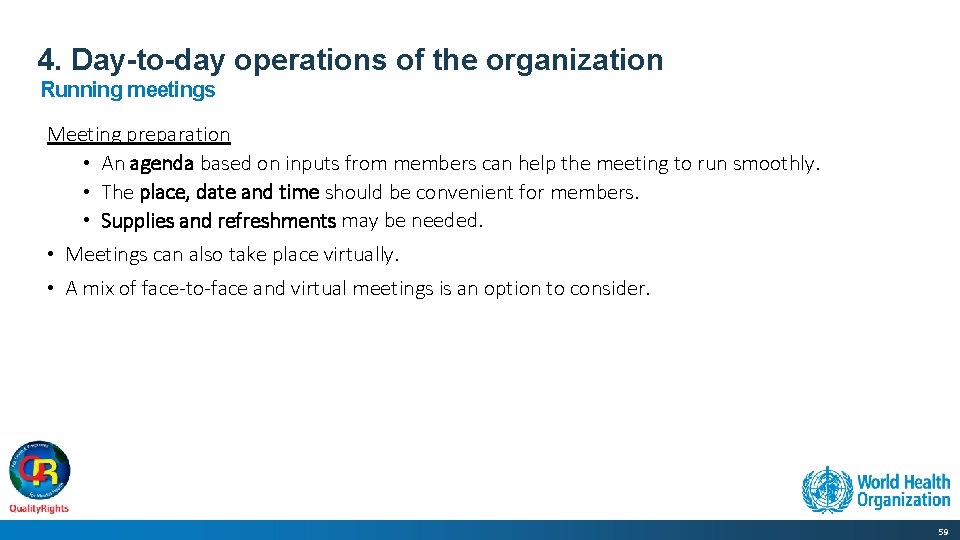
4. Day-to-day operations of the organization Running meetings Meeting preparation • An agenda based on inputs from members can help the meeting to run smoothly. • The place, date and time should be convenient for members. • Supplies and refreshments may be needed. • Meetings can also take place virtually. • A mix of face-to-face and virtual meetings is an option to consider. 59

4. Day-to-day operations of the organization Running meetings Function of meetings • Specific functions of meetings are determined by the group’s goals and objectives e. g. : • A group on promoting human rights may use meetings to plan key advocacy activities. • The function and purpose of meetings should be both specific and relevant to the work being carried out. • Some organizations may use meetings to disseminate information, others may use the time in planning activities and events. • Meetings offer the opportunity for members to share valuable input and to contribute to the overall work and vision of the organization. 60
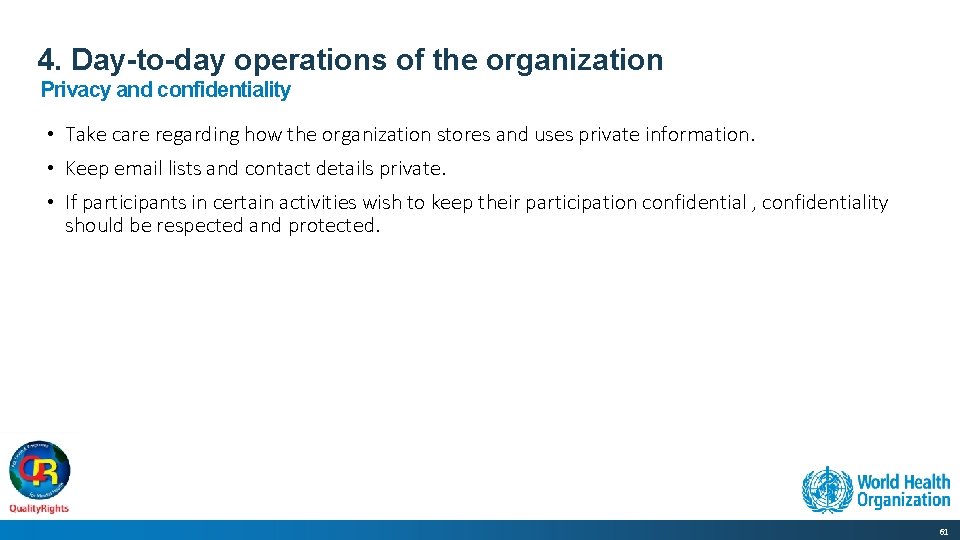
4. Day-to-day operations of the organization Privacy and confidentiality • Take care regarding how the organization stores and uses private information. • Keep email lists and contact details private. • If participants in certain activities wish to keep their participation confidential , confidentiality should be respected and protected. 61

4. Day-to-day operations of the organization Welcoming and engaging new members • New members should be made to feel comfortable • People who contribute should be valued and encouraged. • People who experienced discrimination or rights violations may not feel confident about joining a group. • Make clear that participation in activities is voluntary. • Each member will have something unique to offer. • Link members’ strengths and skills with specific activities. 62
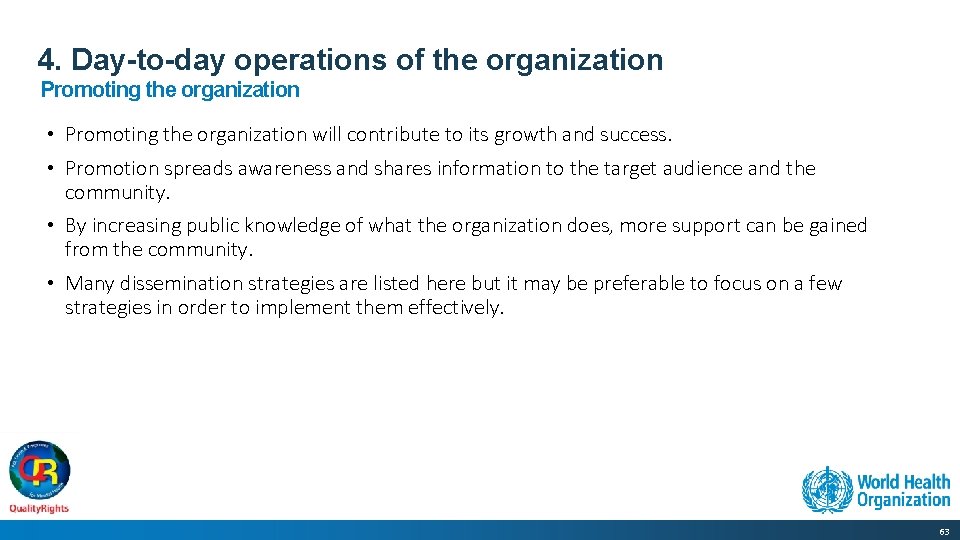
4. Day-to-day operations of the organization Promoting the organization • Promoting the organization will contribute to its growth and success. • Promotion spreads awareness and shares information to the target audience and the community. • By increasing public knowledge of what the organization does, more support can be gained from the community. • Many dissemination strategies are listed here but it may be preferable to focus on a few strategies in order to implement them effectively. 63
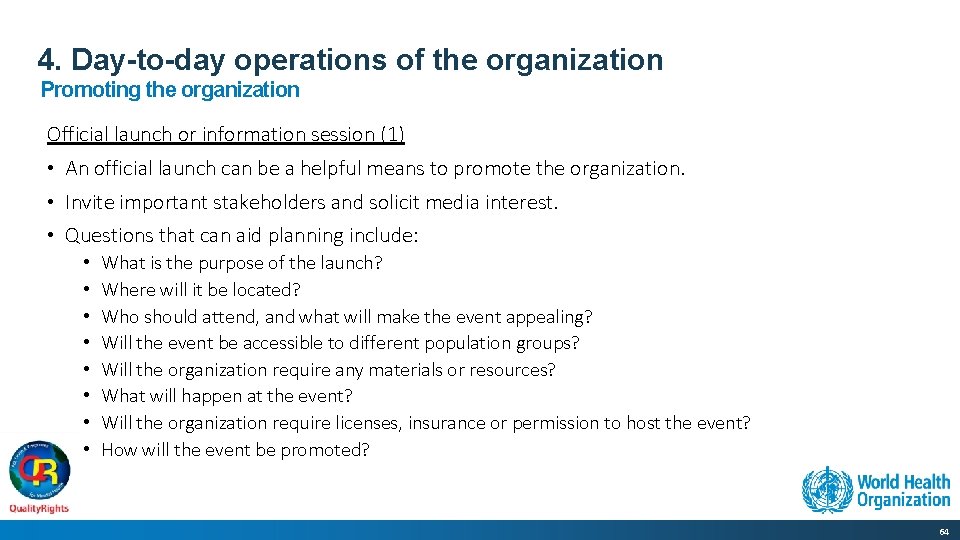
4. Day-to-day operations of the organization Promoting the organization Official launch or information session (1) • An official launch can be a helpful means to promote the organization. • Invite important stakeholders and solicit media interest. • Questions that can aid planning include: • • What is the purpose of the launch? Where will it be located? Who should attend, and what will make the event appealing? Will the event be accessible to different population groups? Will the organization require any materials or resources? What will happen at the event? Will the organization require licenses, insurance or permission to host the event? How will the event be promoted? 64
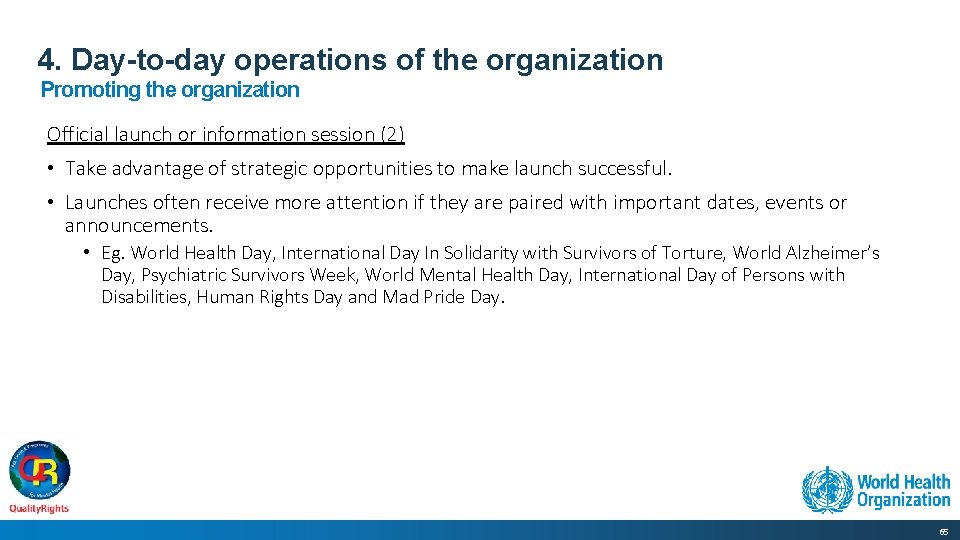
4. Day-to-day operations of the organization Promoting the organization Official launch or information session (2) • Take advantage of strategic opportunities to make launch successful. • Launches often receive more attention if they are paired with important dates, events or announcements. • Eg. World Health Day, International Day In Solidarity with Survivors of Torture, World Alzheimer’s Day, Psychiatric Survivors Week, World Mental Health Day, International Day of Persons with Disabilities, Human Rights Day and Mad Pride Day. 65
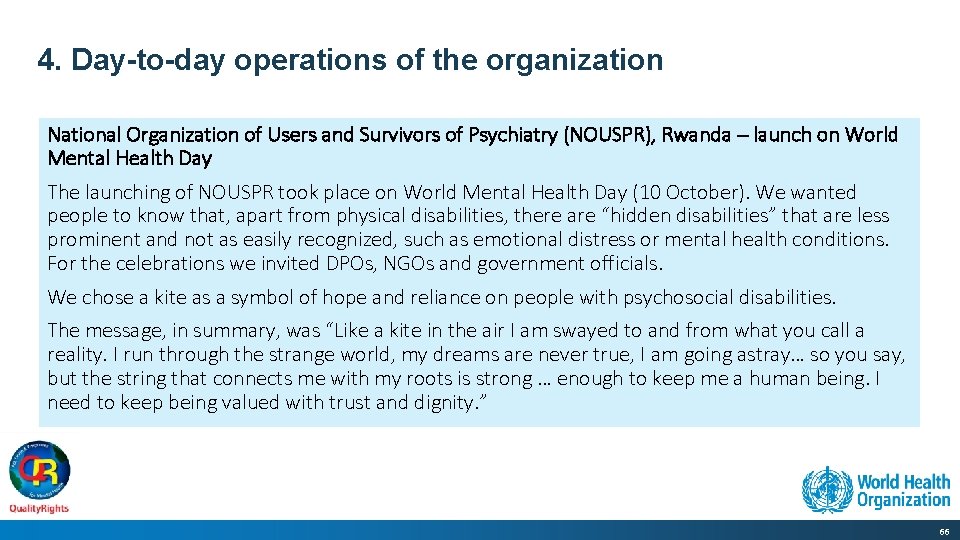
4. Day-to-day operations of the organization National Organization of Users and Survivors of Psychiatry (NOUSPR), Rwanda – launch on World Mental Health Day The launching of NOUSPR took place on World Mental Health Day (10 October). We wanted people to know that, apart from physical disabilities, there are “hidden disabilities” that are less prominent and not as easily recognized, such as emotional distress or mental health conditions. For the celebrations we invited DPOs, NGOs and government officials. We chose a kite as a symbol of hope and reliance on people with psychosocial disabilities. The message, in summary, was “Like a kite in the air I am swayed to and from what you call a reality. I run through the strange world, my dreams are never true, I am going astray… so you say, but the string that connects me with my roots is strong … enough to keep me a human being. I need to keep being valued with trust and dignity. ” 66
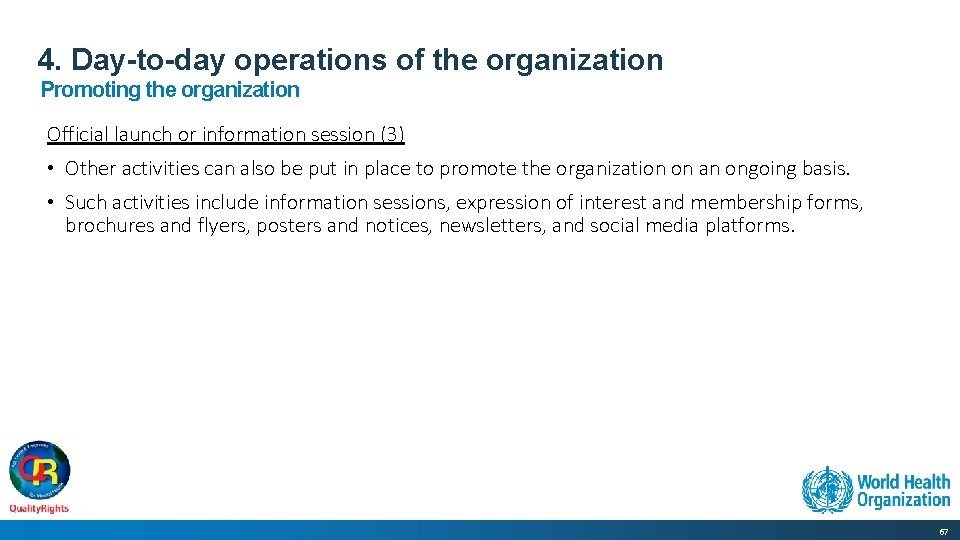
4. Day-to-day operations of the organization Promoting the organization Official launch or information session (3) • Other activities can also be put in place to promote the organization on an ongoing basis. • Such activities include information sessions, expression of interest and membership forms, brochures and flyers, posters and notices, newsletters, and social media platforms. 67
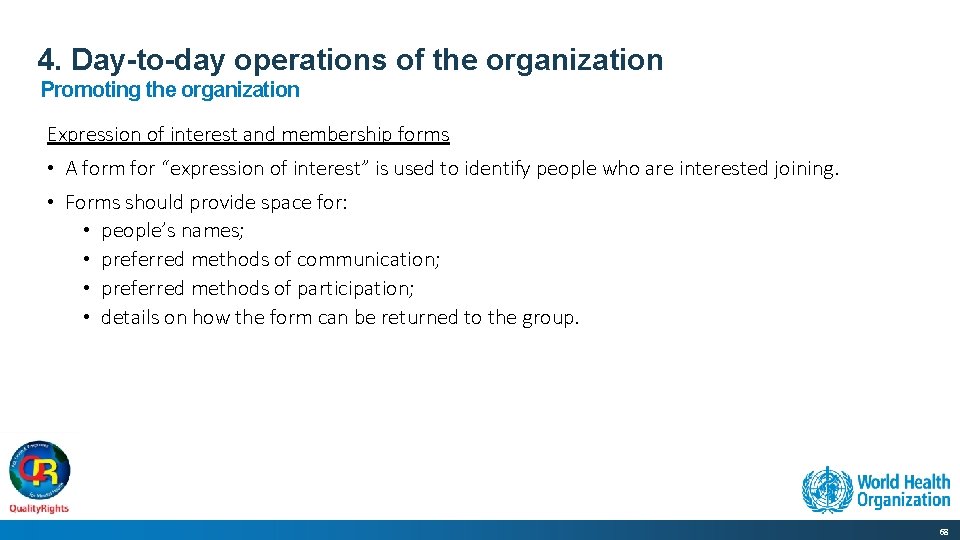
4. Day-to-day operations of the organization Promoting the organization Expression of interest and membership forms • A form for “expression of interest” is used to identify people who are interested joining. • Forms should provide space for: • people’s names; • preferred methods of communication; • preferred methods of participation; • details on how the form can be returned to the group. 68
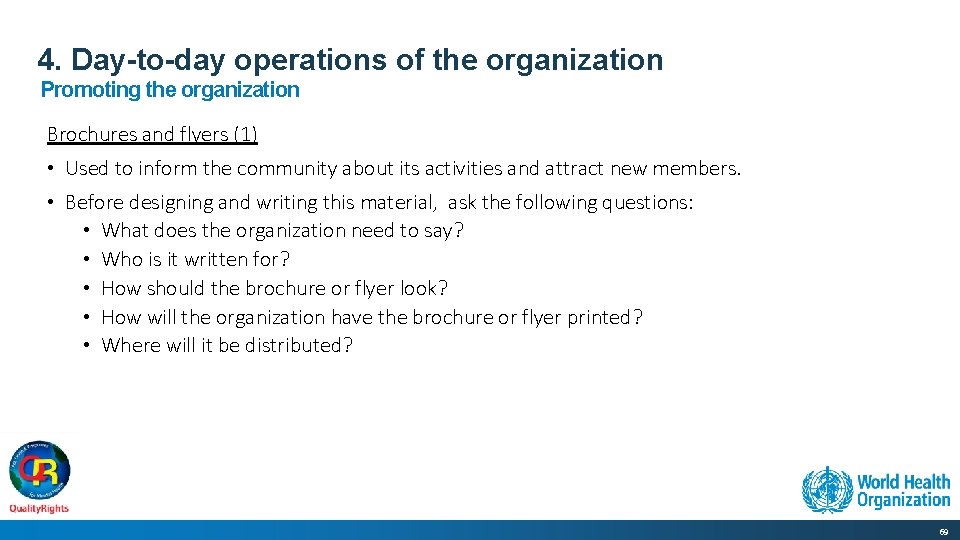
4. Day-to-day operations of the organization Promoting the organization Brochures and flyers (1) • Used to inform the community about its activities and attract new members. • Before designing and writing this material, ask the following questions: • What does the organization need to say? • Who is it written for? • How should the brochure or flyer look? • How will the organization have the brochure or flyer printed? • Where will it be distributed? 69
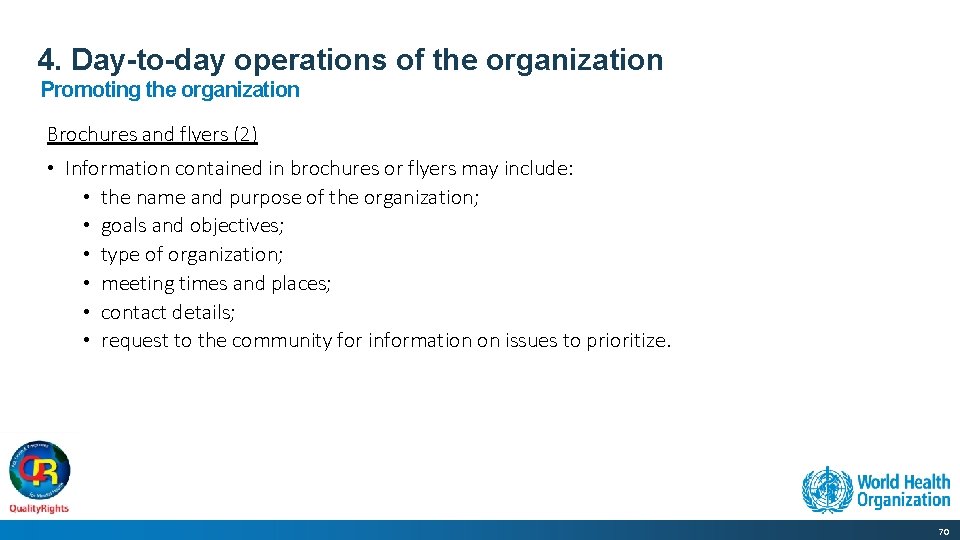
4. Day-to-day operations of the organization Promoting the organization Brochures and flyers (2) • Information contained in brochures or flyers may include: • the name and purpose of the organization; • goals and objectives; • type of organization; • meeting times and places; • contact details; • request to the community for information on issues to prioritize. 70
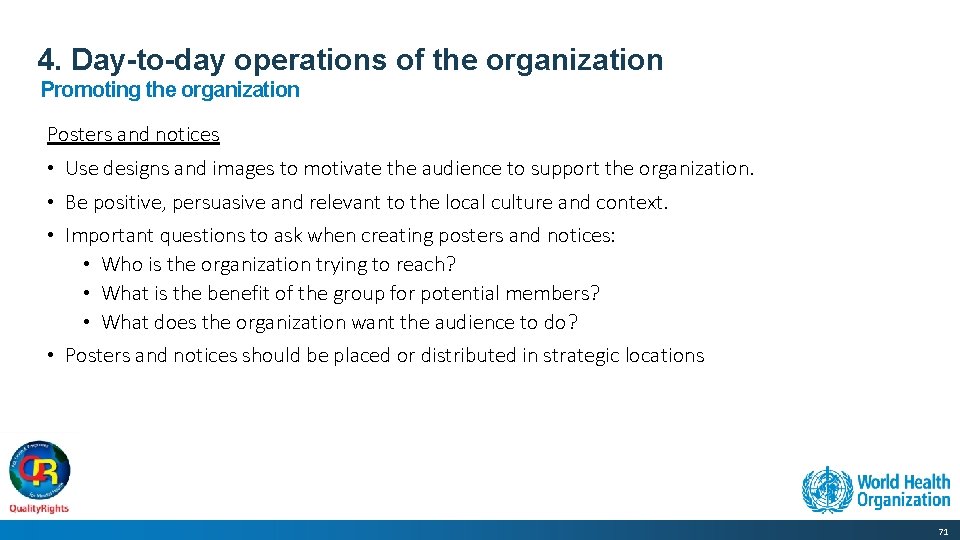
4. Day-to-day operations of the organization Promoting the organization Posters and notices • Use designs and images to motivate the audience to support the organization. • Be positive, persuasive and relevant to the local culture and context. • Important questions to ask when creating posters and notices: • Who is the organization trying to reach? • What is the benefit of the group for potential members? • What does the organization want the audience to do? • Posters and notices should be placed or distributed in strategic locations 71
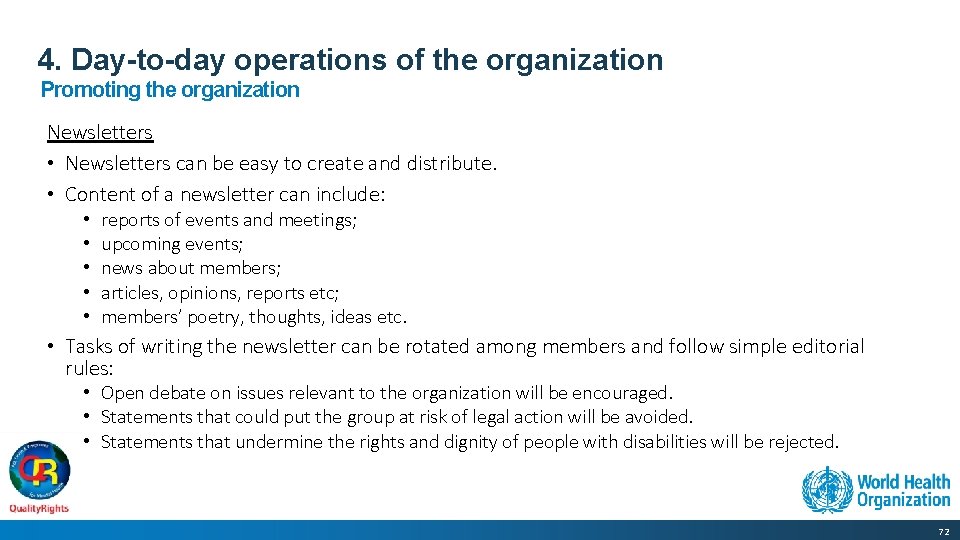
4. Day-to-day operations of the organization Promoting the organization Newsletters • Newsletters can be easy to create and distribute. • Content of a newsletter can include: • • • reports of events and meetings; upcoming events; news about members; articles, opinions, reports etc; members’ poetry, thoughts, ideas etc. • Tasks of writing the newsletter can be rotated among members and follow simple editorial rules: • Open debate on issues relevant to the organization will be encouraged. • Statements that could put the group at risk of legal action will be avoided. • Statements that undermine the rights and dignity of people with disabilities will be rejected. 72
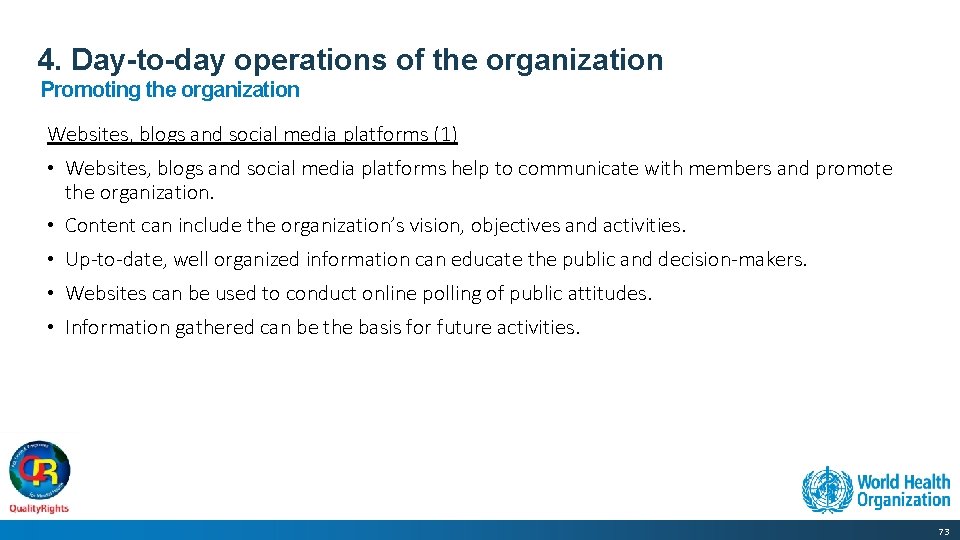
4. Day-to-day operations of the organization Promoting the organization Websites, blogs and social media platforms (1) • Websites, blogs and social media platforms help to communicate with members and promote the organization. • Content can include the organization’s vision, objectives and activities. • Up-to-date, well organized information can educate the public and decision-makers. • Websites can be used to conduct online polling of public attitudes. • Information gathered can be the basis for future activities. 73
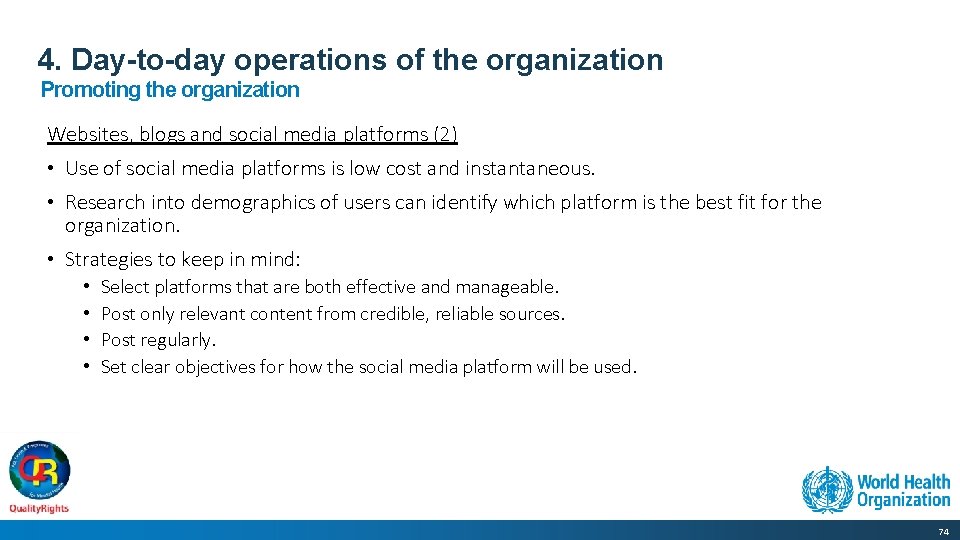
4. Day-to-day operations of the organization Promoting the organization Websites, blogs and social media platforms (2) • Use of social media platforms is low cost and instantaneous. • Research into demographics of users can identify which platform is the best fit for the organization. • Strategies to keep in mind: • • Select platforms that are both effective and manageable. Post only relevant content from credible, reliable sources. Post regularly. Set clear objectives for how the social media platform will be used. 74
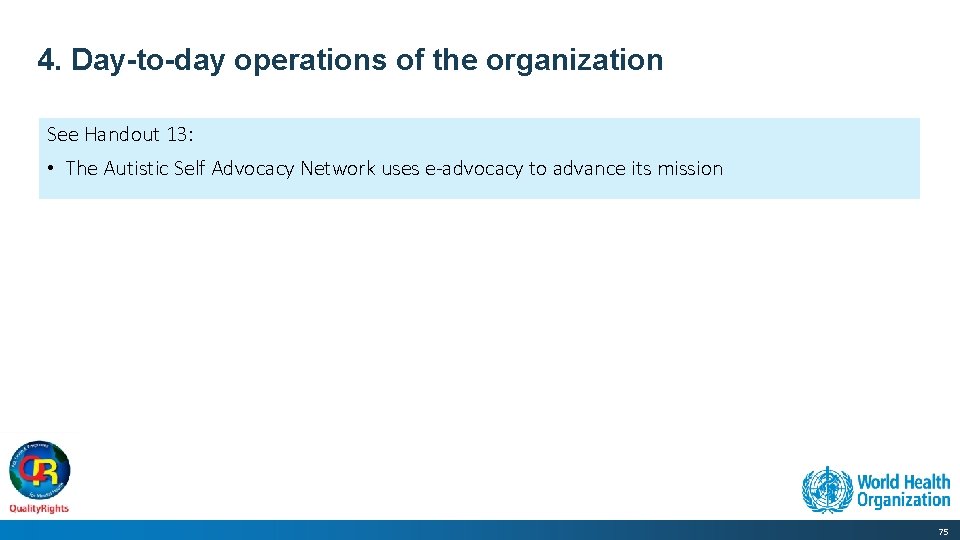
4. Day-to-day operations of the organization See Handout 13: • The Autistic Self Advocacy Network uses e-advocacy to advance its mission 75
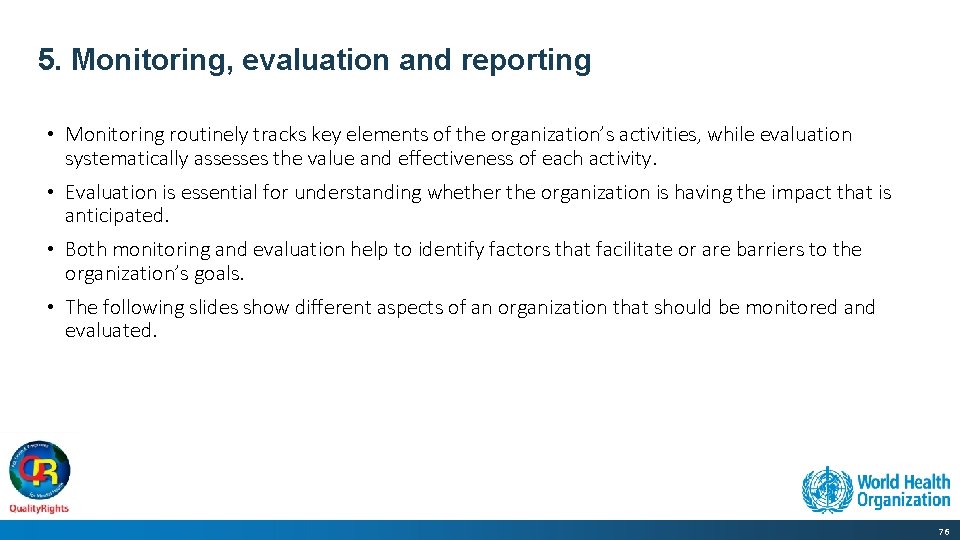
5. Monitoring, evaluation and reporting • Monitoring routinely tracks key elements of the organization’s activities, while evaluation systematically assesses the value and effectiveness of each activity. • Evaluation is essential for understanding whether the organization is having the impact that is anticipated. • Both monitoring and evaluation help to identify factors that facilitate or are barriers to the organization’s goals. • The following slides show different aspects of an organization that should be monitored and evaluated. 76
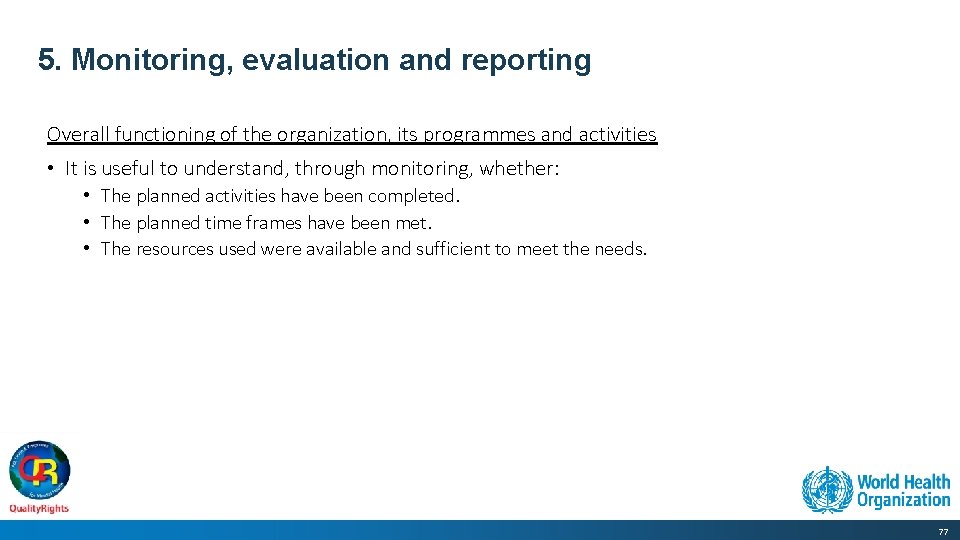
5. Monitoring, evaluation and reporting Overall functioning of the organization, its programmes and activities • It is useful to understand, through monitoring, whether: • The planned activities have been completed. • The planned time frames have been met. • The resources used were available and sufficient to meet the needs. 77
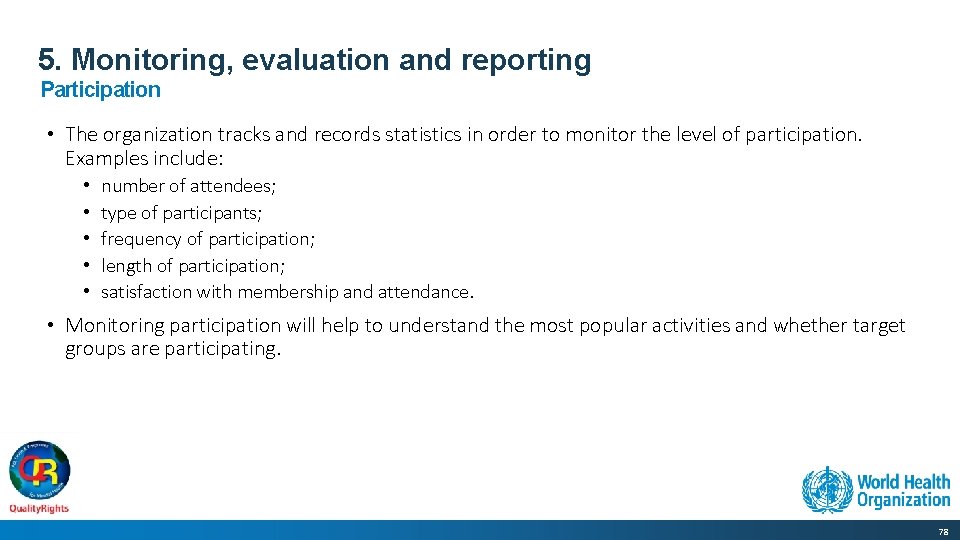
5. Monitoring, evaluation and reporting Participation • The organization tracks and records statistics in order to monitor the level of participation. Examples include: • • • number of attendees; type of participants; frequency of participation; length of participation; satisfaction with membership and attendance. • Monitoring participation will help to understand the most popular activities and whether target groups are participating. 78
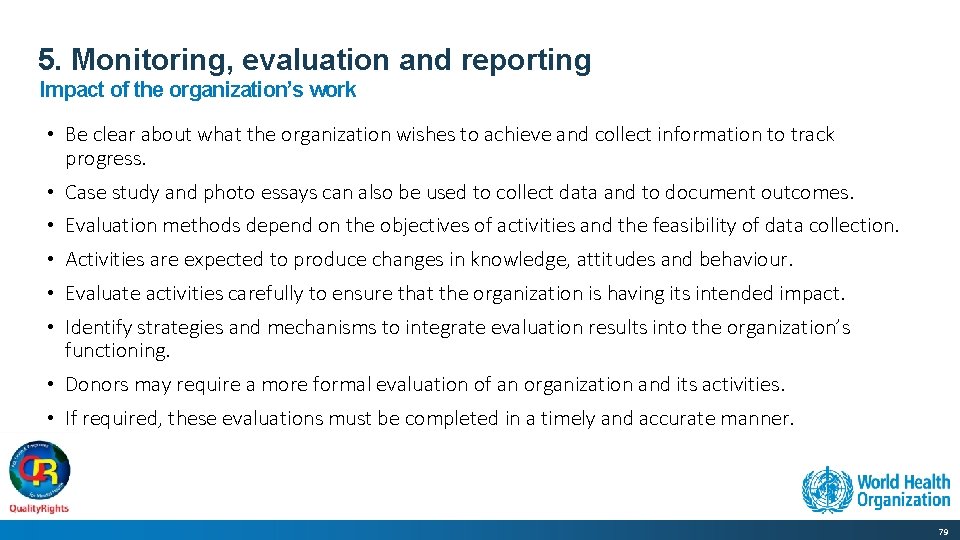
5. Monitoring, evaluation and reporting Impact of the organization’s work • Be clear about what the organization wishes to achieve and collect information to track progress. • Case study and photo essays can also be used to collect data and to document outcomes. • Evaluation methods depend on the objectives of activities and the feasibility of data collection. • Activities are expected to produce changes in knowledge, attitudes and behaviour. • Evaluate activities carefully to ensure that the organization is having its intended impact. • Identify strategies and mechanisms to integrate evaluation results into the organization’s functioning. • Donors may require a more formal evaluation of an organization and its activities. • If required, these evaluations must be completed in a timely and accurate manner. 79
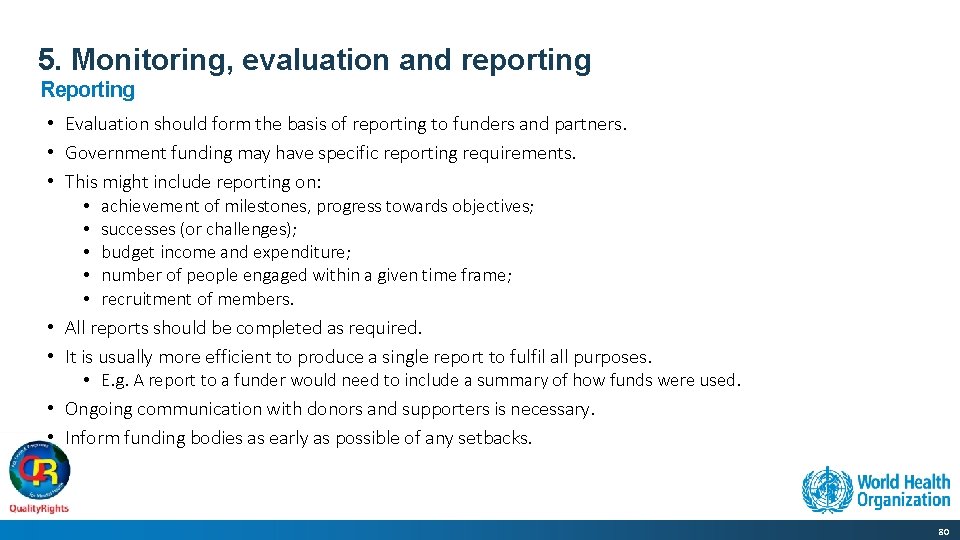
5. Monitoring, evaluation and reporting Reporting • Evaluation should form the basis of reporting to funders and partners. • Government funding may have specific reporting requirements. • This might include reporting on: • achievement of milestones, progress towards objectives; • successes (or challenges); • budget income and expenditure; • number of people engaged within a given time frame; • recruitment of members. • All reports should be completed as required. • It is usually more efficient to produce a single report to fulfil all purposes. • E. g. A report to a funder would need to include a summary of how funds were used. • Ongoing communication with donors and supporters is necessary. • Inform funding bodies as early as possible of any setbacks. 80
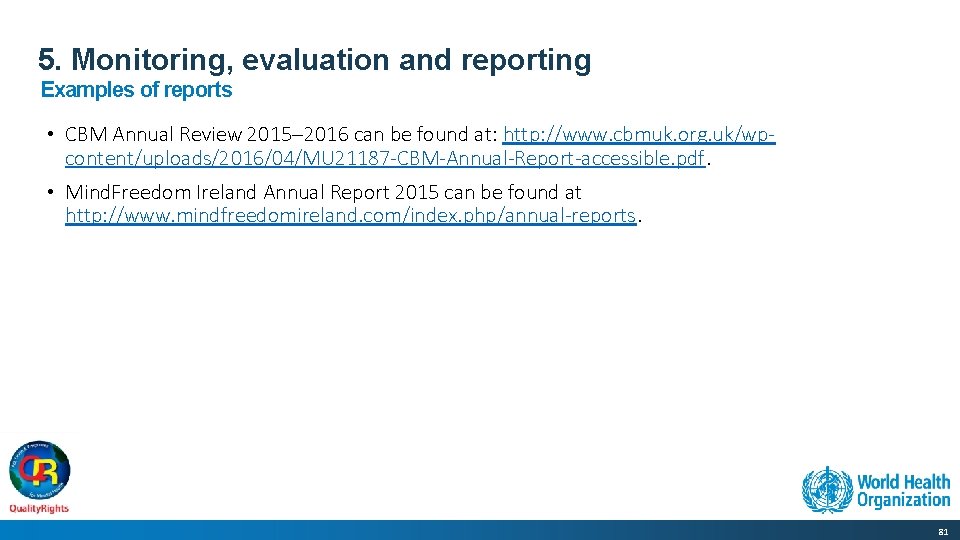
5. Monitoring, evaluation and reporting Examples of reports • CBM Annual Review 2015 2016 can be found at: http: //www. cbmuk. org. uk/wpcontent/uploads/2016/04/MU 21187 -CBM-Annual-Report-accessible. pdf. • Mind. Freedom Ireland Annual Report 2015 can be found at http: //www. mindfreedomireland. com/index. php/annual-reports. 81
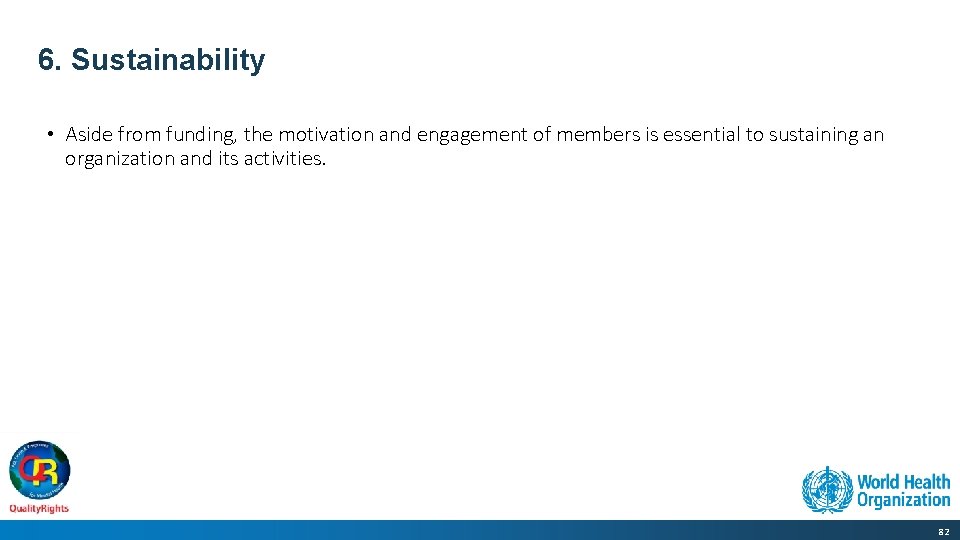
6. Sustainability • Aside from funding, the motivation and engagement of members is essential to sustaining an organization and its activities. 82
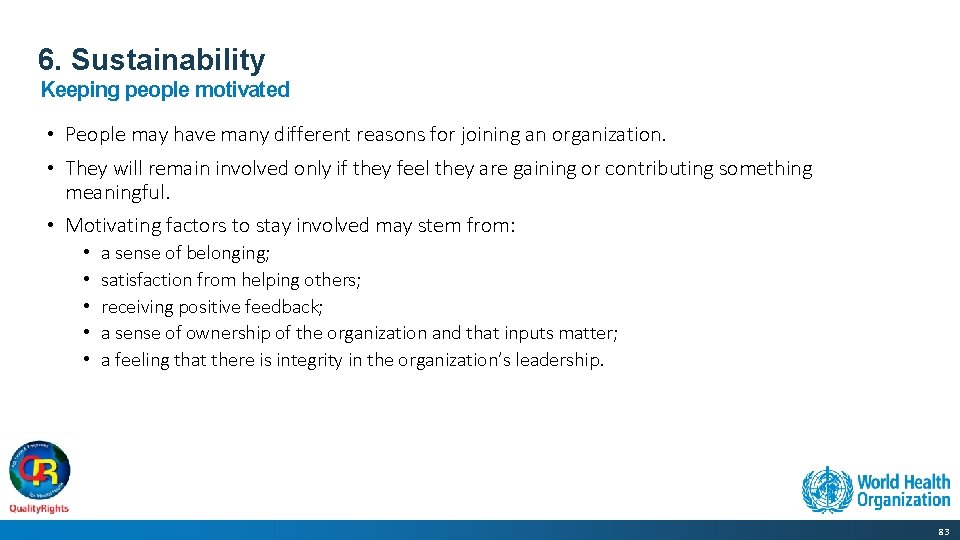
6. Sustainability Keeping people motivated • People may have many different reasons for joining an organization. • They will remain involved only if they feel they are gaining or contributing something meaningful. • Motivating factors to stay involved may stem from: • • • a sense of belonging; satisfaction from helping others; receiving positive feedback; a sense of ownership of the organization and that inputs matter; a feeling that there is integrity in the organization’s leadership. 83
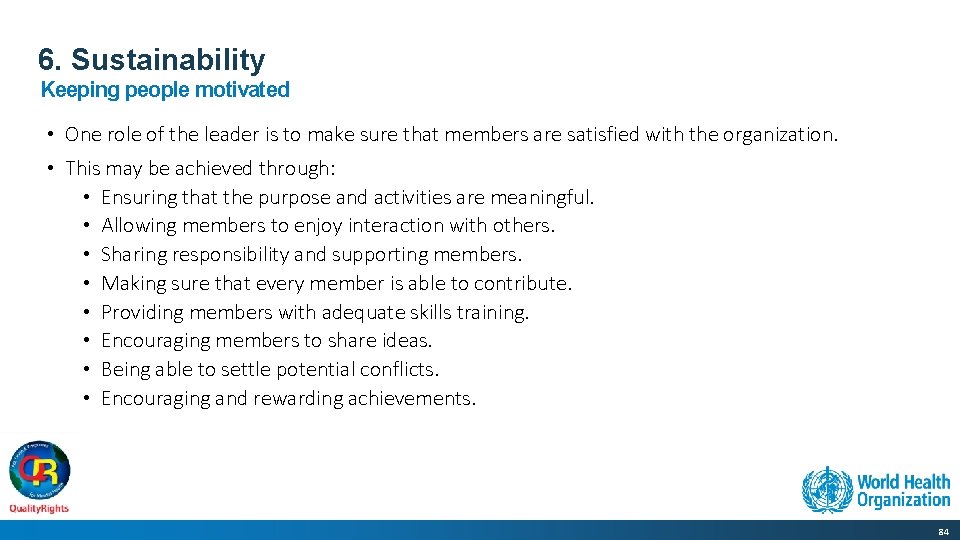
6. Sustainability Keeping people motivated • One role of the leader is to make sure that members are satisfied with the organization. • This may be achieved through: • Ensuring that the purpose and activities are meaningful. • Allowing members to enjoy interaction with others. • Sharing responsibility and supporting members. • Making sure that every member is able to contribute. • Providing members with adequate skills training. • Encouraging members to share ideas. • Being able to settle potential conflicts. • Encouraging and rewarding achievements. 84
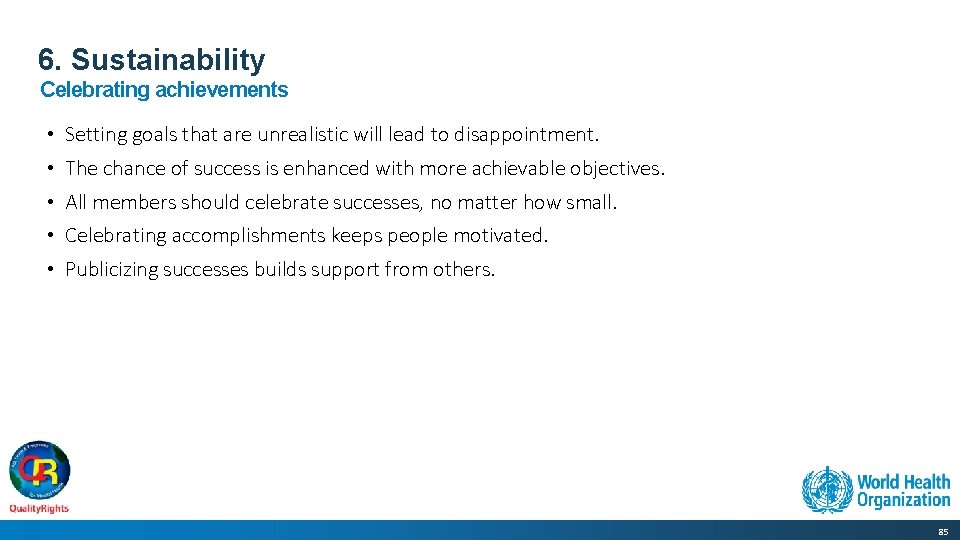
6. Sustainability Celebrating achievements • Setting goals that are unrealistic will lead to disappointment. • The chance of success is enhanced with more achievable objectives. • All members should celebrate successes, no matter how small. • Celebrating accomplishments keeps people motivated. • Publicizing successes builds support from others. 85
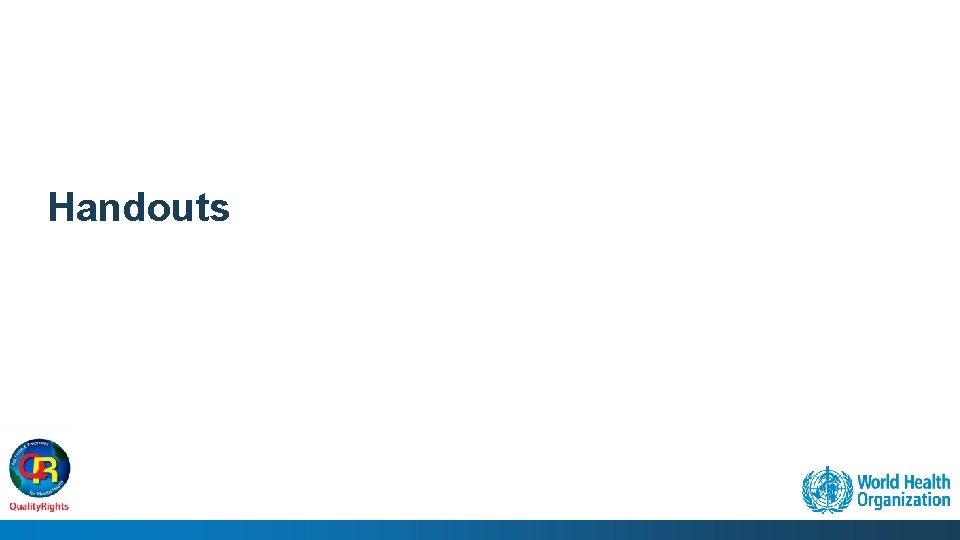
Handouts
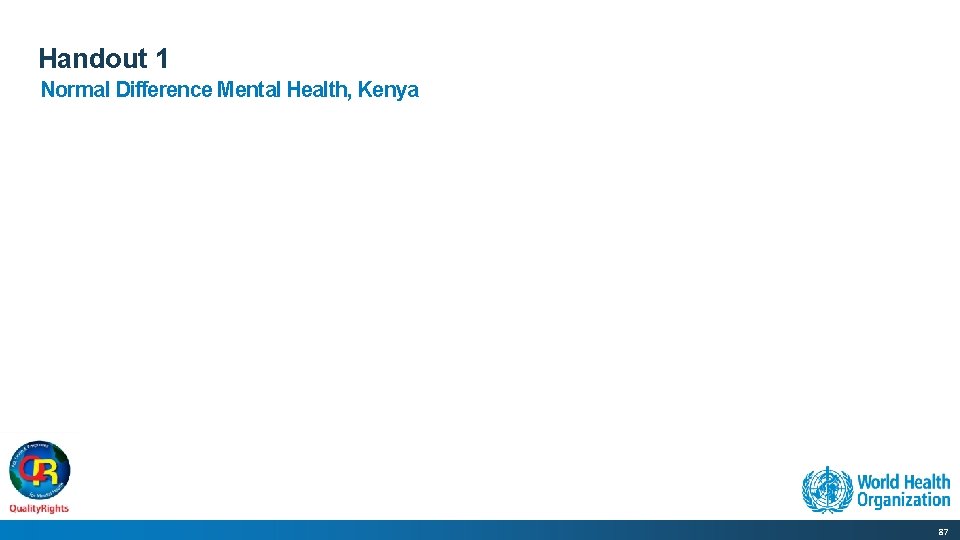
Handout 1 Normal Difference Mental Health, Kenya 87
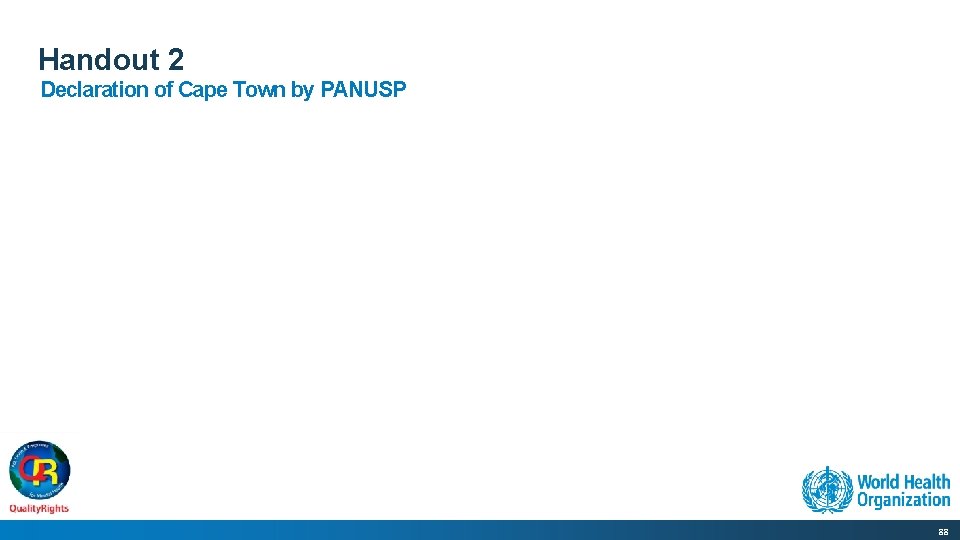
Handout 2 Declaration of Cape Town by PANUSP 88
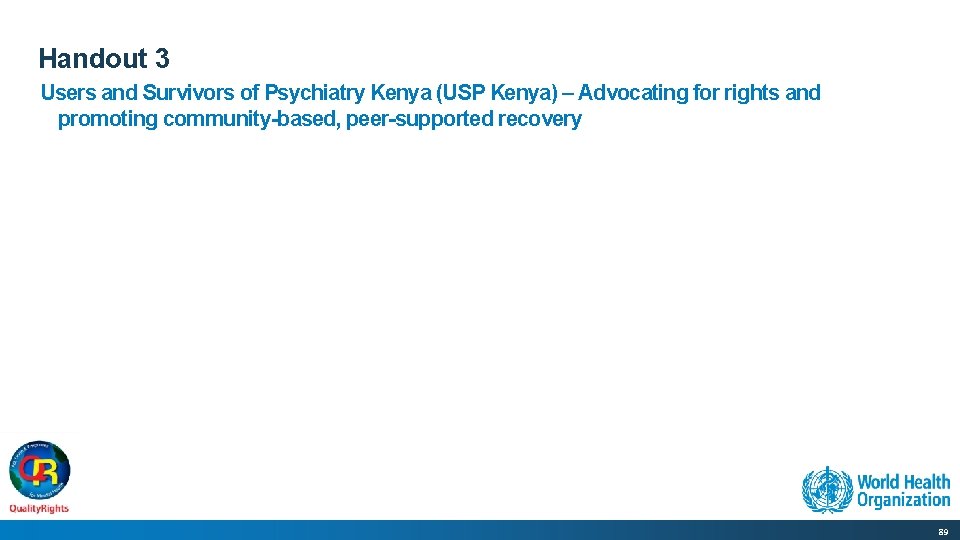
Handout 3 Users and Survivors of Psychiatry Kenya (USP Kenya) – Advocating for rights and promoting community-based, peer-supported recovery 89
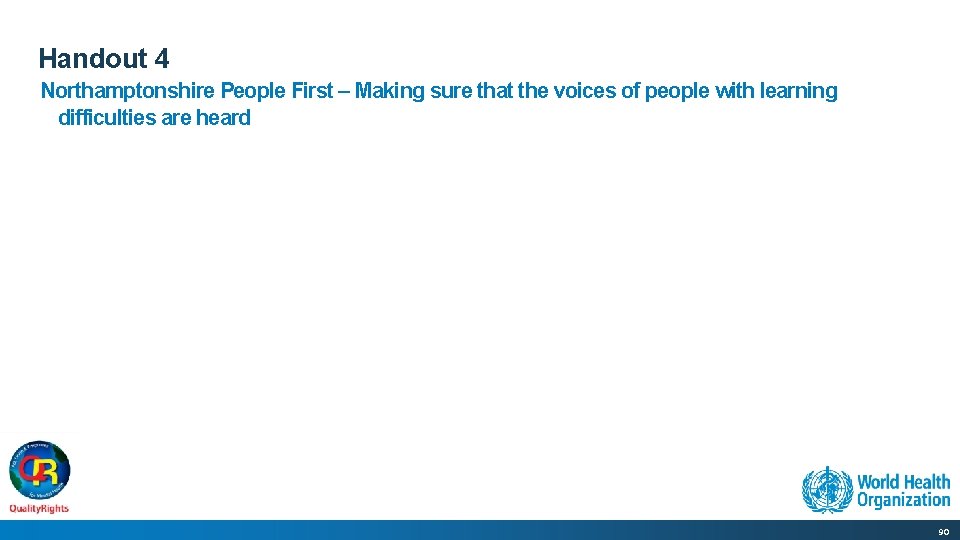
Handout 4 Northamptonshire People First – Making sure that the voices of people with learning difficulties are heard 90
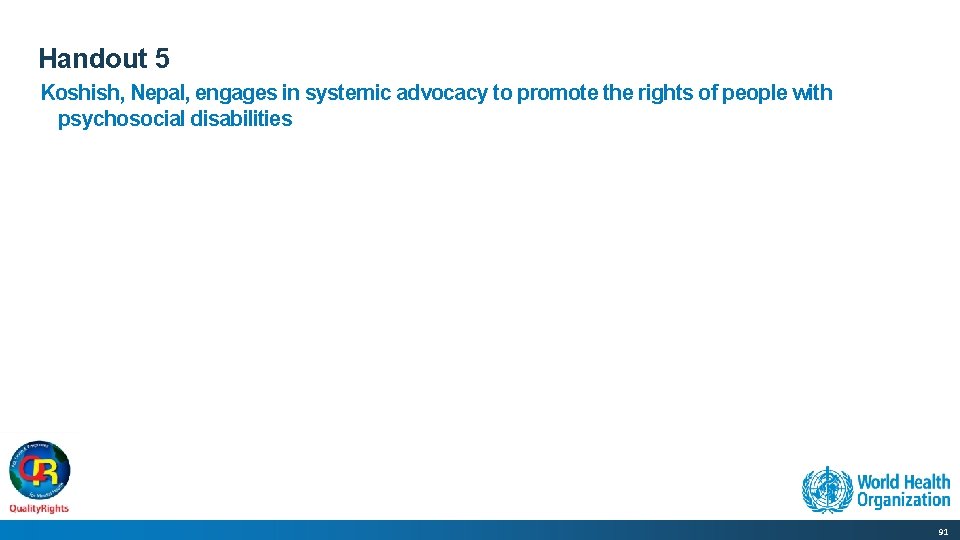
Handout 5 Koshish, Nepal, engages in systemic advocacy to promote the rights of people with psychosocial disabilities 91
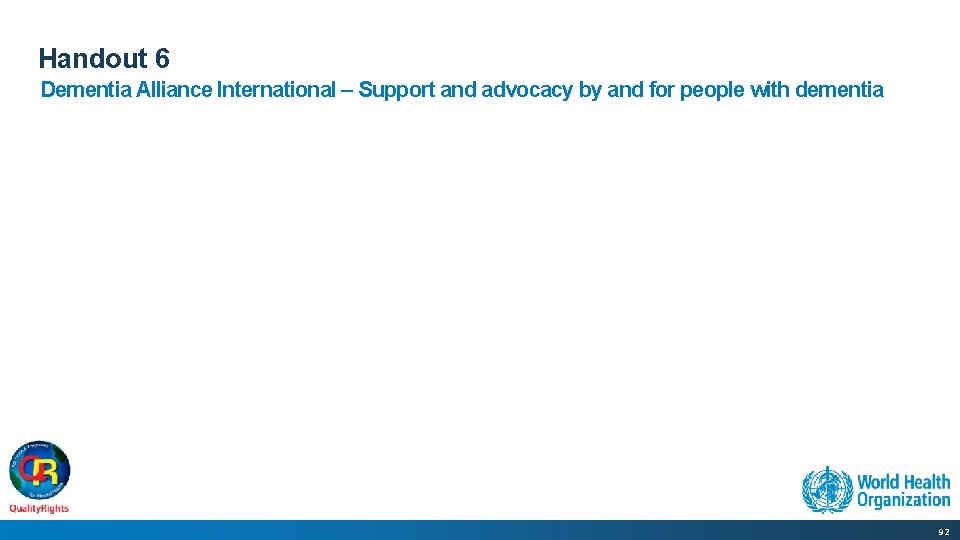
Handout 6 Dementia Alliance International Support and advocacy by and for people with dementia 92
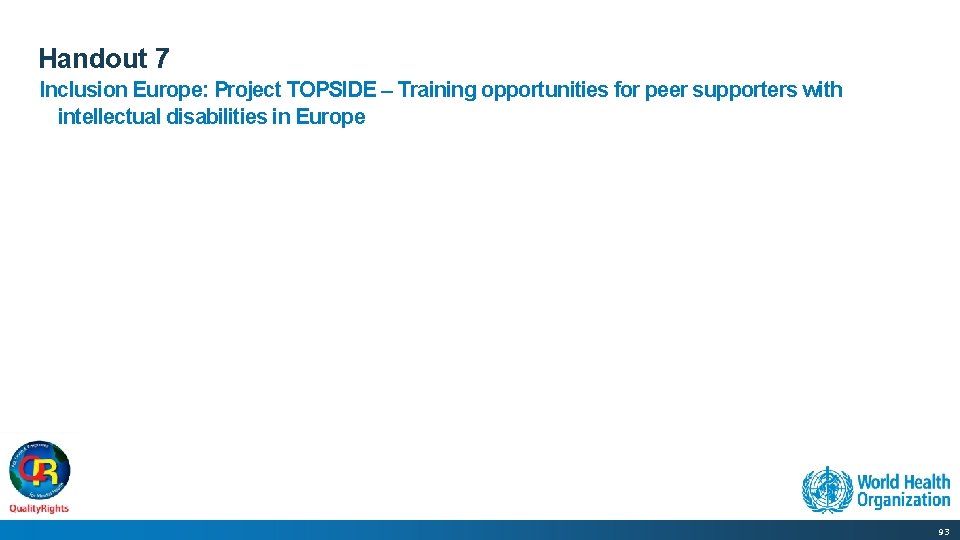
Handout 7 Inclusion Europe: Project TOPSIDE Training opportunities for peer supporters with intellectual disabilities in Europe 93
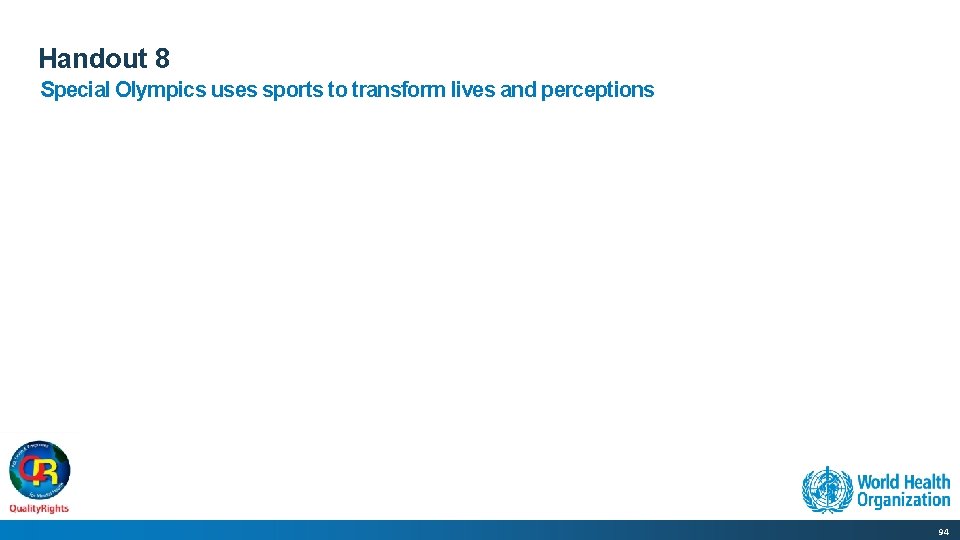
Handout 8 Special Olympics uses sports to transform lives and perceptions 94
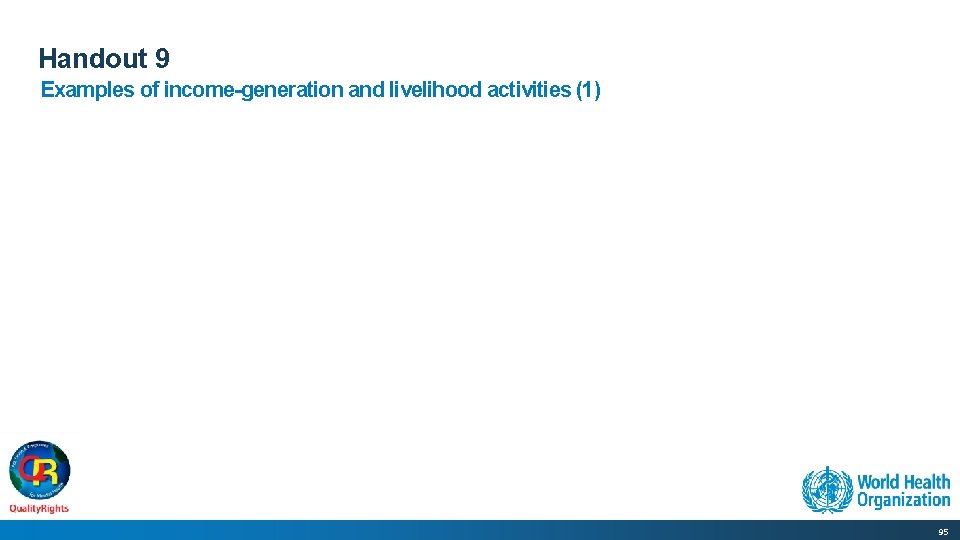
Handout 9 Examples of income-generation and livelihood activities (1) 95
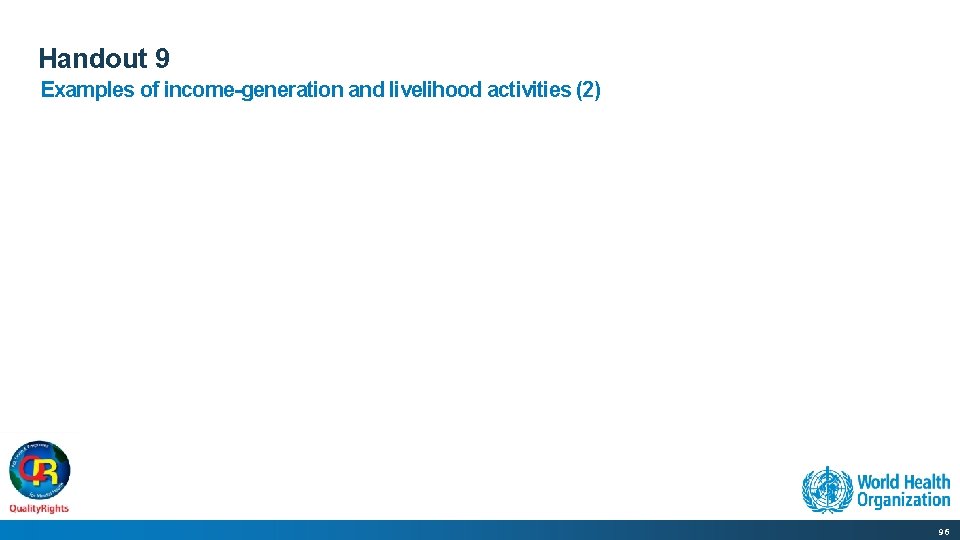
Handout 9 Examples of income-generation and livelihood activities (2) 96
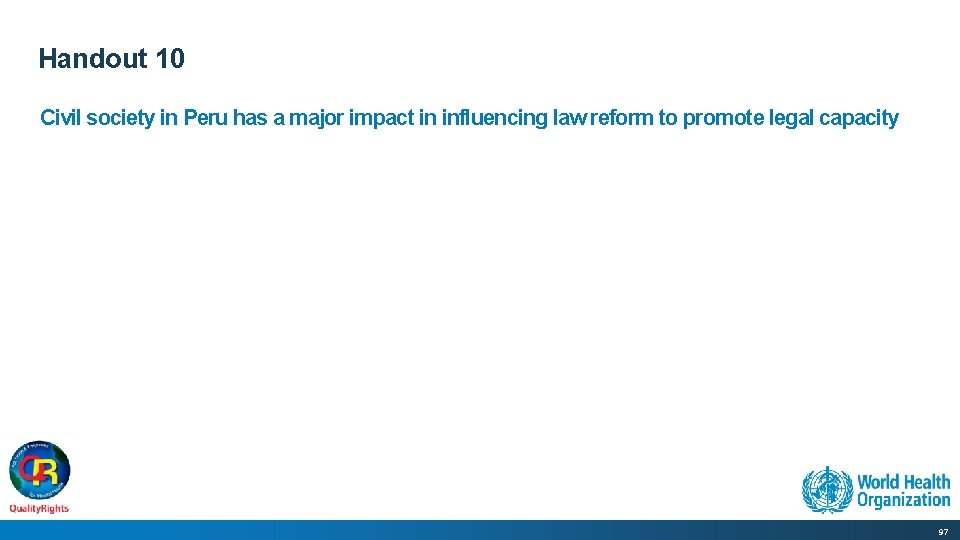
Handout 10 Civil society in Peru has a major impact in influencing law reform to promote legal capacity 97
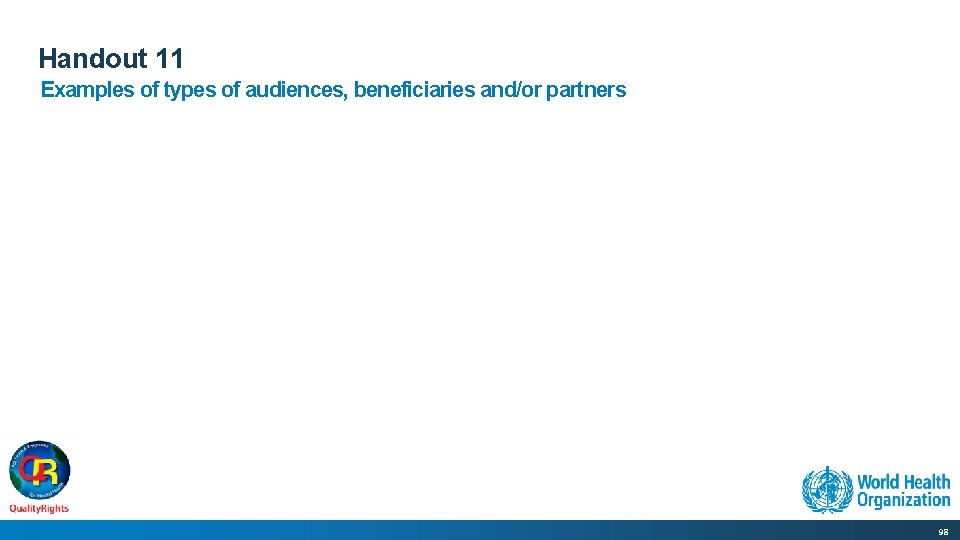
Handout 11 Examples of types of audiences, beneficiaries and/or partners 98
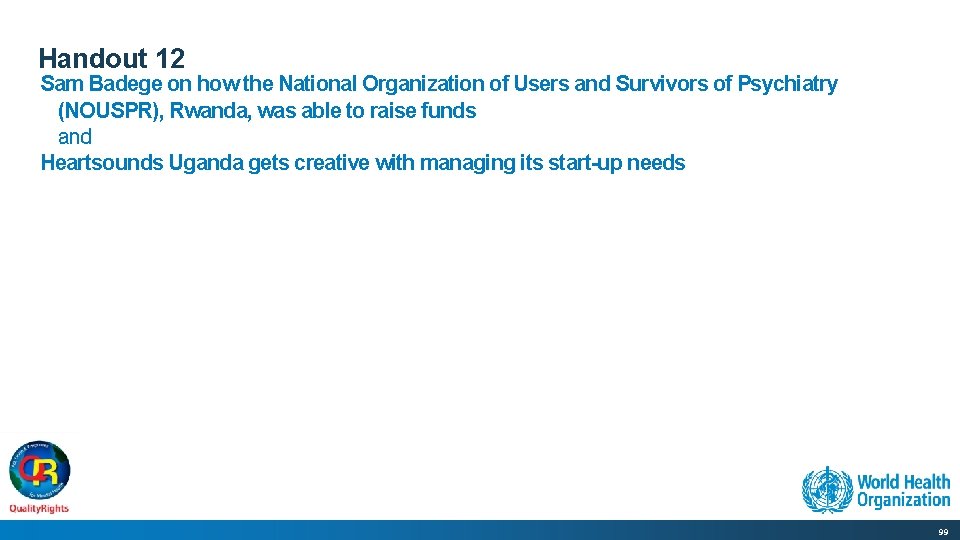
Handout 12 Sam Badege on how the National Organization of Users and Survivors of Psychiatry (NOUSPR), Rwanda, was able to raise funds and Heartsounds Uganda gets creative with managing its start-up needs 99
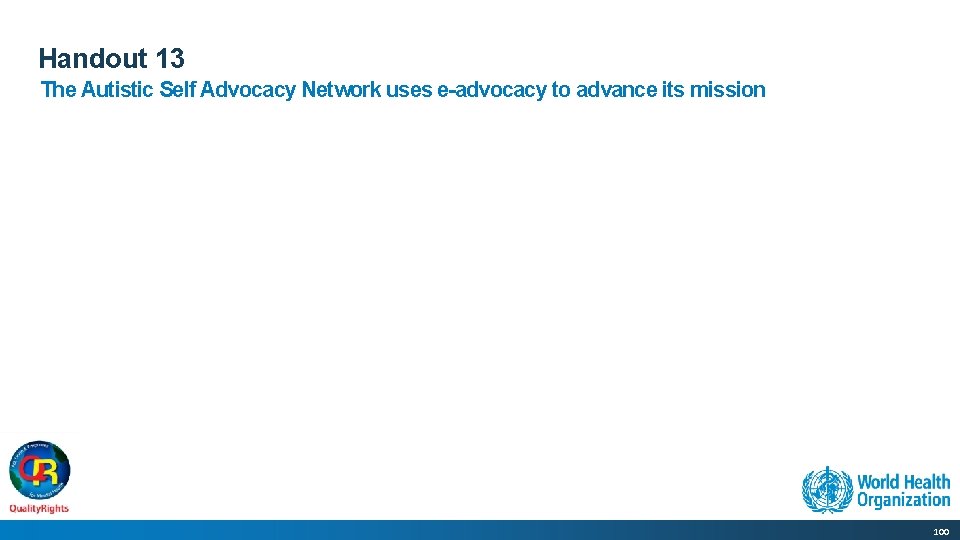
Handout 13 The Autistic Self Advocacy Network uses e-advocacy to advance its mission 100
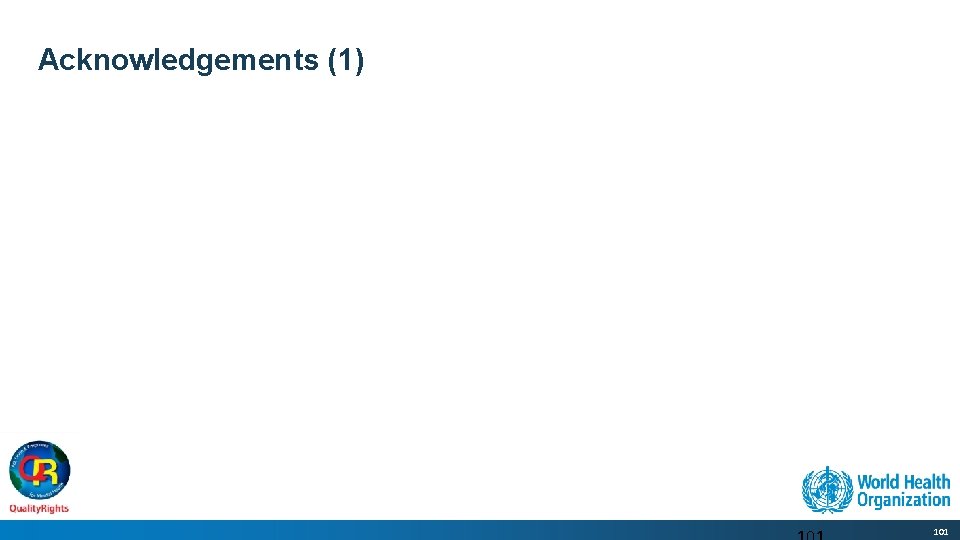
Acknowledgements (1) 101
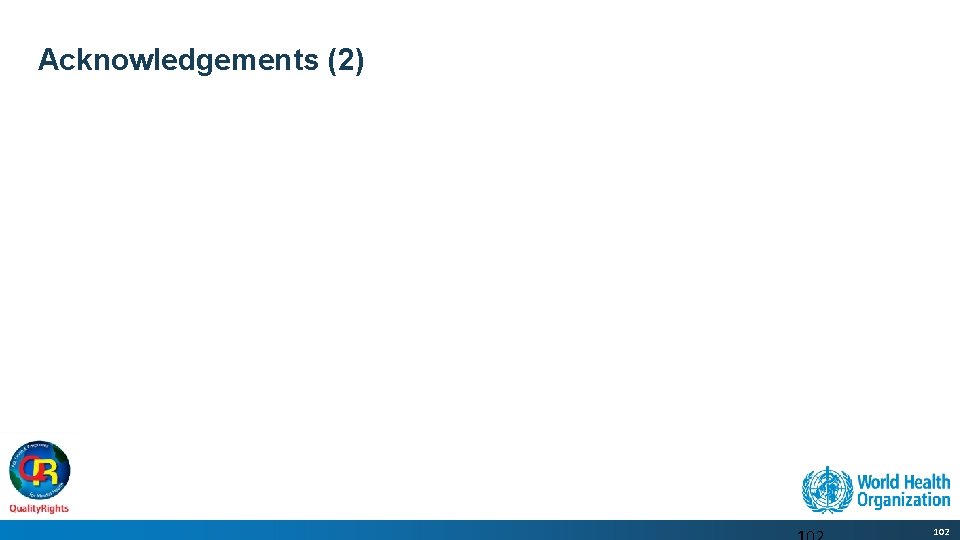
Acknowledgements (2) 102
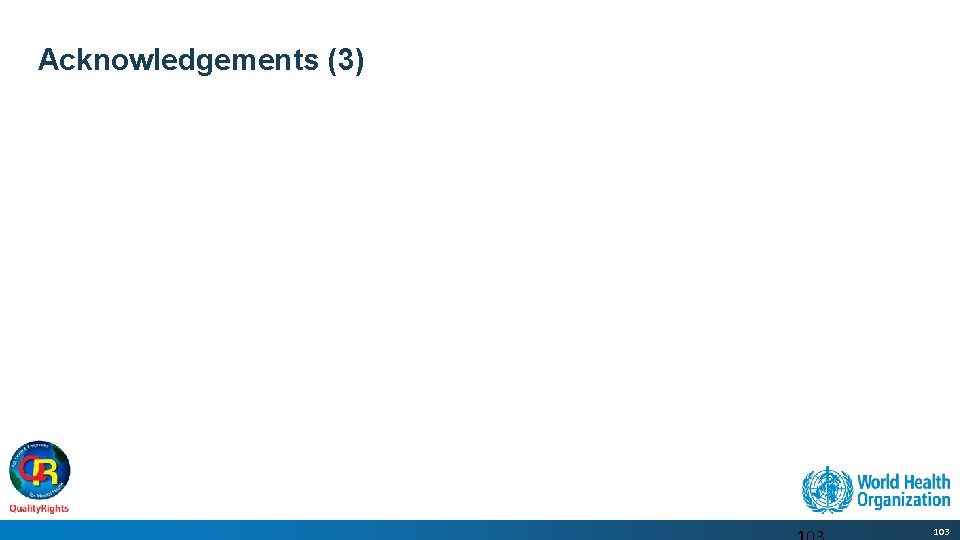
Acknowledgements (3) 103
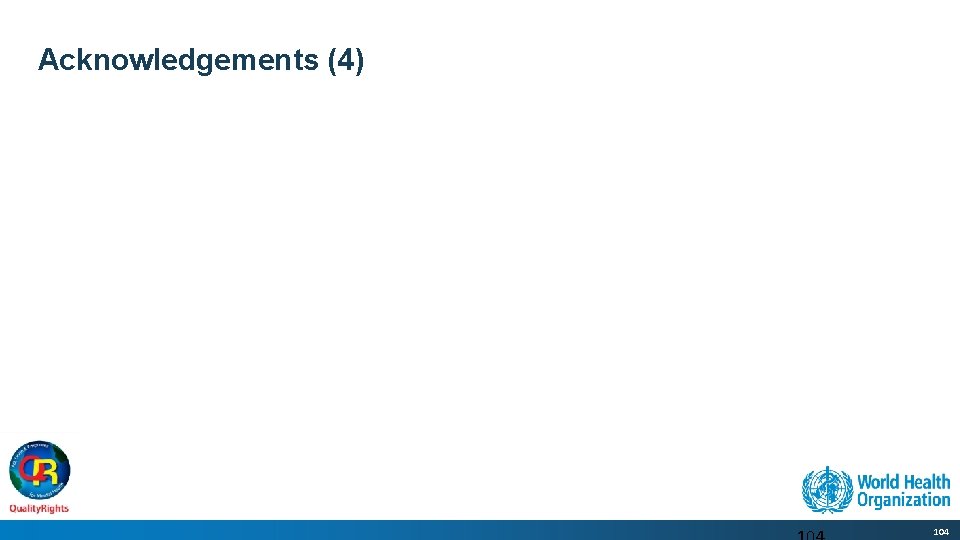
Acknowledgements (4) 104
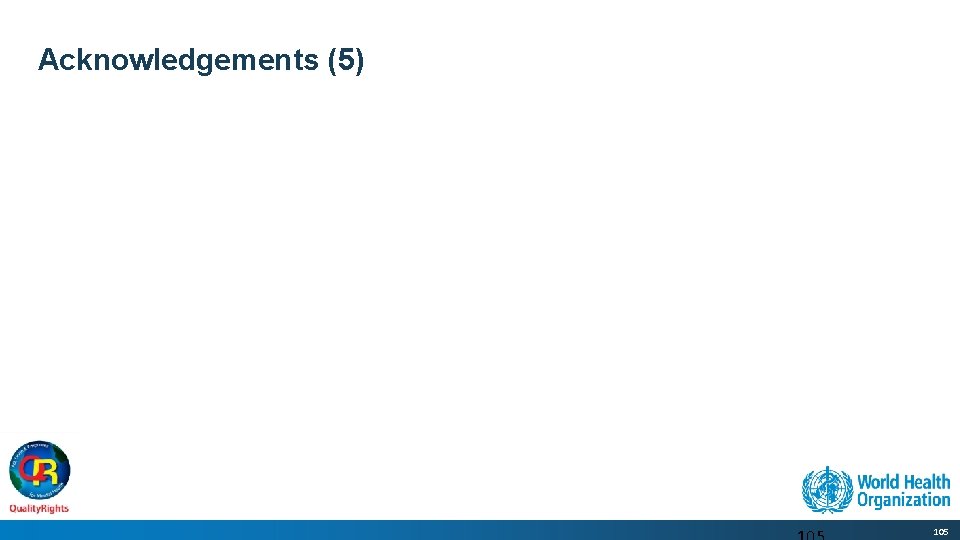
Acknowledgements (5) 105
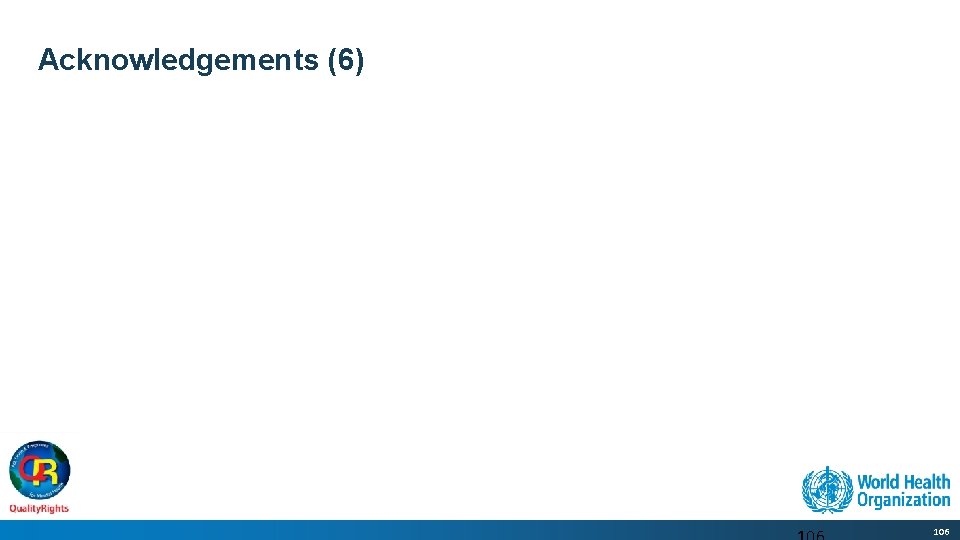
Acknowledgements (6) 106
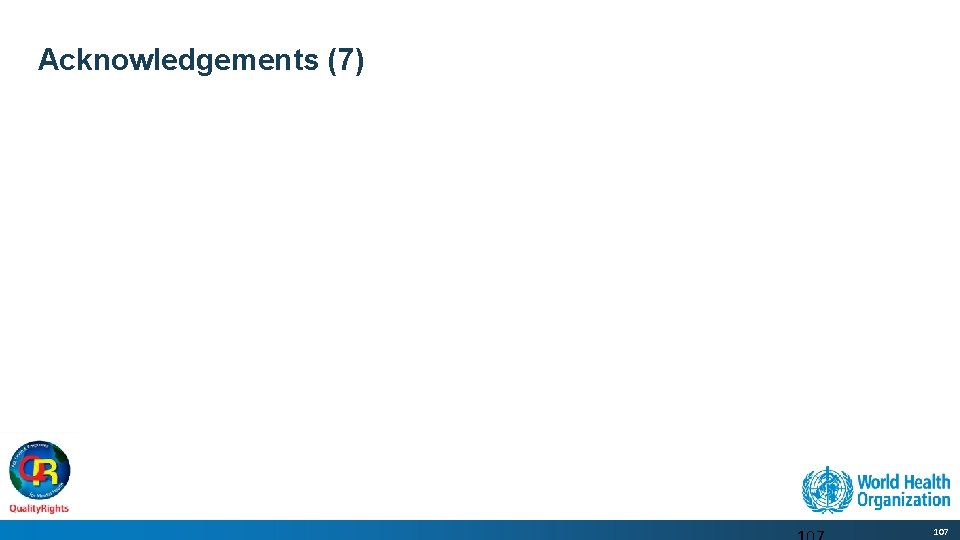
Acknowledgements (7) 107
- Slides: 107